How to Lead a Research Team
- First Online: 01 January 2020

Cite this chapter

- Aimee-Noelle Swanson 2
1207 Accesses
Leadership. Organizational culture. Managing dynamic teams. Providing effective feedback. Did you miss this course in your advanced training? Is this the class that you slept through only to show up for the final exam – or was that really just a dream? You didn’t, and it was only a dream. Being an intentional leader and building the culture you want to maximize workflow and employee satisfaction is not something that is taught in graduate school. Very few institutions provide a didactic to scientists on how you build an effective organizational structure to deliver the best science possible. In academia, you are taught to think critically; to be a careful, well-reasoned scientist and clinician; and to approach problems with an objective eye, determine the root cause, and create impactful solutions. You are not taught how to be an effective leader, how to hire the right staff, how to engage teams in work during stressful periods, how to provide effective feedback to enhance performance, and how to build trust in a diverse team. However, you do have all of the tools that you need to do all of these things. You’ve been doing them for years and have seen them all around you. Now it’s just a matter of recognizing them for what they are and connecting with them in a way that serves your goals and objectives. That is the point of this chapter. In this chapter we will cover building an intentional organizational culture, being a thoughtful leader, and managing a research team so that with some foresight and effort, you can focus on your science while engaging your staff in meaningful, high-impact work as a team.
This is a preview of subscription content, log in via an institution to check access.
Access this chapter
- Available as PDF
- Read on any device
- Instant download
- Own it forever
- Available as EPUB and PDF
- Compact, lightweight edition
- Dispatched in 3 to 5 business days
- Free shipping worldwide - see info
Tax calculation will be finalised at checkout
Purchases are for personal use only
Institutional subscriptions
Suggested Reading
These texts are valuable management and leadership tools for scientists. Consider these as key reference materials to set yourself up for success.
Google Scholar
Allen D. Getting things done: the art of stress-free productivity, revised edition. New York: Penguin Books; 2015.
Barker K. At the Helm: leading your laboratory. 2nd ed. Cold Spring Harbor: Cold Spring Harbor Laboratory Press; 2010.
Cohen CM, Cohen SL. Lab dynamics: management and leadership skills for scientists. 2nd ed. Cold Spring Harbor: Cold Spring Harbor Laboratory Press; 2012.
The Harvard Business Review (HRB). 10 Must Reads book series covers a wide range of topics with terrific resources and references.
Making the right moves: a practical guide to scientific management for postdocs and new faculty. 2nd ed. Burroughs Wellcome Fund and Howard Hughes Medical Institute; 2006. https://www.hhmi.org/developing-scientists/making-right-moves .
Patterson K, Grenny J, McMillan R, Switzler A. Crucial conversations: tools for talking when stakes are high. 2nd ed. New York: McGraw-Hill Education; 2011.
Download references
Author information
Authors and affiliations.
Department of Psychiatry and Behavioral Sciences, Stanford University School of Medicine, Stanford, CA, USA
Aimee-Noelle Swanson
You can also search for this author in PubMed Google Scholar
Corresponding author
Correspondence to Aimee-Noelle Swanson .
Editor information
Editors and affiliations.
Laura Weiss Roberts
Rights and permissions
Reprints and permissions
Copyright information
© 2020 Springer Nature Switzerland AG
About this chapter
Swanson, AN. (2020). How to Lead a Research Team. In: Roberts, L. (eds) Roberts Academic Medicine Handbook. Springer, Cham. https://doi.org/10.1007/978-3-030-31957-1_34
Download citation
DOI : https://doi.org/10.1007/978-3-030-31957-1_34
Published : 01 January 2020
Publisher Name : Springer, Cham
Print ISBN : 978-3-030-31956-4
Online ISBN : 978-3-030-31957-1
eBook Packages : Medicine Medicine (R0)
Share this chapter
Anyone you share the following link with will be able to read this content:
Sorry, a shareable link is not currently available for this article.
Provided by the Springer Nature SharedIt content-sharing initiative
- Publish with us
Policies and ethics
- Find a journal
- Track your research
Your browser is not supported
Sorry but it looks as if your browser is out of date. To get the best experience using our site we recommend that you upgrade or switch browsers.
Find a solution
- Skip to main content
- Skip to navigation
- hot-topics Extras
- Newsletters
- Reading room
Tell us what you think. Take part in our reader survey
Celebrating twenty years
- Back to parent navigation item
- Collections
- Water and the environment
- Chemical bonding
- Antimicrobial resistance
- Energy storage and batteries
- AI and automation
- Sustainability
- Research culture
- Nobel prize
- Food science and cookery
- Plastics and polymers
- Periodic table
- Coronavirus

- More from navigation items

Source: © Caroline Knapp
How to lead a research team
By Katrina Krämer 2020-05-06T09:10:00+01:00
- No comments
By building skills to support your lab members, you lay the foundation for success
‘The most challenging thing is the management,’ says chemist Josep Cornella , who has been leading a research team at the Max Planck Institute for Carbon Research in Germany since 2017. ‘I was good in the fumehood, but then they take you out of that, put you in an office and give you eight people to manage.’
While there are other challenges associated with heading up a lab – including attracting funding and preparing lectures – managing a research team is arguably one of the bigger ones. In a recent Wellcome Trust survey of more than 4000 scientists, 80% said they had the skills to manage a diverse team. But of the people being managed, only 11% had been asked for feedback by their supervisor. They also reported experiencing few of the behaviours associated with effective management, like noting achievements, discussing career aspirations and providing support with personal issues.
‘The first step is being aware that your leadership actually affects the output – and being willing to change,’ says Juan Pablo Ruiz, postdoctoral researcher in the department of medicine at the University of Wisconsin-Madison, US, and president of Future of Research , an organisation that seeks to empower junior researchers.
Support diversity
When asked what is most challenging about leading a team, physicist Helen Gleeson from the University of Leeds, UK, replies firmly: ‘Without doubt, the fact that everybody is different and one rule doesn’t fit all.’ Cornella agrees. To get the best out of each team member he quickly needed to accept ‘that not everyone is like you when you were a postdoc … It’s important to have empathy, try to understand people and put yourself in their situation,’ he says.
‘If you look at teams in industry, [particularly] in the tech sector where innovation and creativity is required and fostered, what you see is that teams that score highly in measures of wellbeing also have higher levels of measurable output,’ says Ruiz. ‘Individuals need to feel like they can speak their mind without fearing repercussions and need to feel supported enough to be independent, not micromanaged.’
In Google’s two-year study of 180 of its teams , psychological safety came out as one of the top drivers for successful teamwork. Team members need to feel safe to take risks and be vulnerable in front of each other. Good managers can create this environment by showing concern for success and wellbeing, Google’s related study on manager behaviour found.
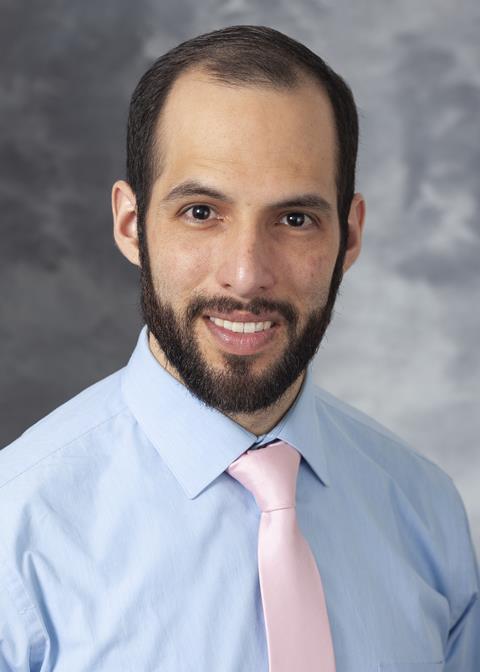
Source: © John Wingren Media Solutions/University of Wisconsin
Juan Pablo Ruiz, postdoc and president of Future of Research
The unfortunate reality of academia is that it has a very hierarchical structure, says Ruiz. ‘When you create this sense of “this person is at the top and they’re untouchable, unreachable,” that’s when you can get a really big power imbalance.’ This not only puts people off providing honest feedback, it can also stop good ideas percolating up.
‘I think the way to address that is to create a culture in which the hierarchy is understood to be for the roles and responsibilities,’ Ruiz explains. Supervisors should make it clear – not just vocally but by action – that team members should speak up if there is anything that needs improving. For many researchers, including Cornella, practising an open-door policy is a straightforward way to invite open discussion and feedback.
At the same time, the distinction between supervisor and supervisees needs to remain clear-cut, says Gleeson. Early in their career, team leaders might not feel comfortable with that distinction and might blur the boundaries too much. ‘That doesn’t matter until it goes wrong – for example, if you have to have a discussion about the students not working very hard,’ she stresses.
Create freedom to learn
‘I think the thing that makes a big difference in a student–supervisor relationship is allowing the student to take ownership of the project as early as possible,’ says Gleeson, who won Times Higher Education ’s outstanding research supervisor award in 2018. ‘That’s hard because very often it was your idea, and you might be under a lot of pressure to get publications out.’
Cornella recalls that early on in his career he used to see every team member in the lab every day. ‘Not to put pressure on them, but just out of curiosity,’ he explains. ‘But of course the students or postdocs can feel it as pressure.’ As time went on, he started giving his researchers more freedom. ‘By doing that, [my team] came up with things that I would never do, but really interesting things, and things that surprised me,’ Cornella says.
Like many of his peers, Cornella’s only management experience prior to starting his independent career came from supervising students in the lab during his time as a PhD student and postdoctoral researcher. Fewer than half of respondents to the Wellcome survey said they had formal management training.
First-time supervisors shouldn’t feel like they need to know everything
Some universities have introduced mandatory training for both new and existing supervisors. University College London, UK, where organometallic chemist Clare Bakewell started her independent career in 2018, is one of them . Bakewell did a two-hour online training course, which covered policies, assessment and case studies like students reporting harassment or difficulties with a project. ‘The scenarios were useful, they definitely picked up some things I hadn’t ever considered to be an issue,’ she says.
At the same time, Bakewell suggests some ways the training could be improved. New starters receive an almost overwhelming amount of information and have to do a number of other courses at the same time. The impact of the supervision training therefore risks being diluted. ‘You do it once when you first join, but is that still going to be relevant a couple of years down the line?’ she asks. ‘I think having a refresher course would be really useful.’
Bakewell stresses that first-time supervisors shouldn’t feel like they need to know everything. ‘As long as you know the right channels to advise people to go down, that’s important.’ She currently leads a team of four, including co-supervising one PhD student. Gleeson’s university runs a scheme in which first-time supervisors choose a more experienced researcher with similar subject expertise to act as co-supervisor.
Take a break

Source: © Markus Wahle
A weekend of hiking helps keep Helen Gleeson’s lab motivated
While a research group’s main job is to do research, other activities can help team members stay motivated. ‘In the department and my group in particular we do a lot of outreach activities,’ says Gleeson. ‘It’s something students can get a real buzz from.’
‘I do think there is value in stepping away from the usual environment,’ says Luis Martinez , chemistry professor and director of the Center for Innovation and Entrepreneurship at Trinity University, US. Gleeson agrees with this; she rents a bunkhouse for her group to stay in over a weekend once a year. ‘But I think it’s important to recognise that not everybody will want to engage with these activities,’ she cautions. ‘So these [activities] aren’t compulsory.’
Jennifer Heemstra , a chemist at Emory University, US, also holds an annual off-site retreat. Over the course of several days, the group works on research ideas, funding proposals and even ideas on how to stay on top of new literature.
At the retreat, ‘people are putting in their time and mental energy for projects they don’t work on,’ Heemstra explains. ‘It turns out we’re really motivated by these altruistic things.’ In the long run, this means that instead of being jealous of each other’s successes, the entire team celebrates a new publication or successful grant application.
Get cultured
A lot of management focuses on a one-to-one relationship between lab leader and team members. But it might be worth thinking about the bigger picture. Martinez says that ‘every team needs to do deep thinking about how to make every member be valued and recognised’. Research groups could do more to communicate their mission and the things that inspire and motivate them, Martinez says.
While details about research and publications are familiar sights on scientists’ websites, a few have also started to add details about their lab culture. Heemstra’s lab website features a diversity statement. On University of Kansas biologist Prachee Avasthi ’s website, a lab policies section details her approach to career development and work schedules.

Source: © Kay Hinton
Jennifer Heemstra (right) in the lab with graduate student Colin Swenson
‘What we do is not just have individual goals but create goals for the entire group for each year,’ says Heemstra, who also writes a blog about research culture. ‘Almost everything we’re doing is pretty standard in a lot of businesses, but as academic labs, we’ve been slow to adopt these practices.’ Since many corporate practices translate well into a lab environment, magazines like Harvard Business Review are a good start for learning about how to become better at managing people or what makes an effective communicator, she says.
Martinez agrees. He says researchers should talk to colleagues in other fields about their supervising practices or borrow principles from start-up culture. ‘As you read [books like Eric Ries’ The Lean Startup ], you realise “Wow, this really maps out the scientific method”,’ he says.
‘To help foster more expertise, PIs should train for leadership – not necessarily train themselves, though that’s important too, but train their trainees for leadership,’ Martinez continues. Communication and critical thinking skills, a taste for taking risks and a tolerance for failure are all incredibly important, he says.
‘We do our research, but then there’s all of these things around how we do our research that can impact how successful we are,’ Heemstra says.
How to lead: Five quick tips
- Value different viewpoints and different ways to do research
- Invite honest feedback from team members
- Encourage team members to take ownership of their work
- Do something other than research, like a team outreach activity or an off-site retreat
- Communicate details about lab culture, goals and mission to team members (and potentially also to others)
- Careers advice
- Collaboration
- Professional development
- research culture
- Working life
Related articles

Wellcome Leap launches global network to tackle pressing health issues
2021-02-04T09:37:00Z
By Rebecca Trager

Catherine Ngila: ‘I am very passionate about empowering my students’
2024-05-03T13:00:00Z
By Jamie Durrani

The untapped power of emotional intelligence for PhDs
2024-04-26T12:00:00Z
By Matteo Tardelli

The striking truth
2024-04-26T08:30:00Z

Empowering voices: Advancing social mobility in the chemical sciences
By Chemistry World

How to teach university-level chemistry well
2024-04-18T08:30:00Z
By Dinsa Sachan
No comments yet
Only registered users can comment on this article., more from careers.

Troubleshooting your career
2024-04-10T13:30:00Z
By Emma Pewsey

How to troubleshoot experiments
2024-04-10T08:43:00Z
By Victoria Atkinson
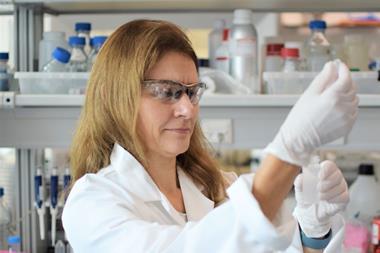
A sustainable career in sustainability
2024-03-28T14:28:00Z
By Julia Robinson

Making science communication persuasive and engaging
2024-03-21T09:30:00Z
By Philipp Gramlich

Losing a job can make you question who you are
2024-03-07T14:30:00Z
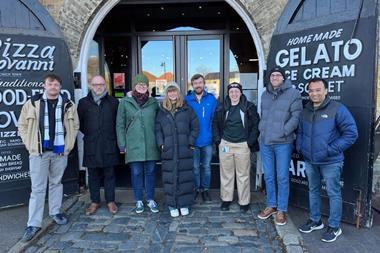
The community of colleagues supporting each other through redundancy
2024-03-07T09:31:00Z
- Contributors
- Terms of use
- Accessibility
- Permissions
- This website collects cookies to deliver a better user experience. See how this site uses cookies .
- This website collects cookies to deliver a better user experience. Do not sell my personal data .
- Este site coleta cookies para oferecer uma melhor experiência ao usuário. Veja como este site usa cookies .
Site powered by Webvision Cloud
Skip to content. | Skip to navigation
Personal tools
- Log in/Register Register

https://www.vitae.ac.uk/doing-research/leadership-development-for-principal-investigators-pis/building-and-managing-a-research-team/building-and-managing-a-research-team
This page has been reproduced from the Vitae website (www.vitae.ac.uk). Vitae is dedicated to realising the potential of researchers through transforming their professional and career development.
- Vitae members' area
Building and managing a research team
Building your team, what is a research team.
What constitutes a research team in one department or institution might be described elsewhere as a research group, research centre, research unit or research institute. Regardless of the terminology used, the key characteristic of a research team is that it comprises a group of people working together in a committed way towards a common research goal.
Research team diversity
There are many different configurations of research teams in academia and boundaries can be 'fuzzy'. They may comprise co-investigators, fractional or pooled staff, technical and clerical staff and postgraduate research students. There may also be inter- and intra-institutional dimensions and increasingly international ones; some team members' contributions may well be largely virtual, via email, phone or videoconference.
Also, team members may have different disciplinary backgrounds, different motivations and aspirations, and different cultural backgrounds. Over time, team members' roles may change from being core (fully dedicated to the research goal) to peripheral (committed to this research goal, but also working in one or more other teams), and vice-versa.
Assessing the balance and composition of your team.
Ideally, the balance and composition of the team in terms of skills, expertise and other contributions will be appropriate to achieve the team's objectives, i.e. for the research goal the team is working towards. The research team leader needs to be confident that team members have, or can develop, the necessary skills and knowledge for the research in hand, and you will make recruitment decisions on that basis.
There is also another perspective on the effective team which it is good to consider. In addition to knowledge, experience and skills individuals have different behavioural traits or characteristics they bring to the way they carry out their work and these can be aligned to particular roles in the team: some are very good at seeing a big picture, others very good at detailed work. Some are very oriented towards action - good at just getting things done; others are natural communicators and networkers. The need for these different roles will emerge at different times and it is worth considering the composition of your team to ensure you have a balance of strengths.
To find out more about specific team roles and the research by Meredith Belbin on which they are based, see the section further down this page.
Managing your team
Your responsibilities as a manager of the group.
These are the responsibilities identified in Adair's action-centred leadership model :
- establish, agree and communicate standards of performance and behaviour
- establish style, culture, approach of the group - soft skill elements
- monitor and maintain discipline, ethics, integrity and focus on objectives
- anticipate and resolve group conflict, struggles or disagreements
- assess and change as necessary the balance and composition of the group
- develop team-working, cooperation, morale and team-spirit
- develop the collective maturity and capability of the group - progressively increase group freedom and authority
- encourage the team towards objectives and aims - motivate the group and provide a collective sense of purpose
- identify, develop and agree team- and project-leadership roles within group
- enable, facilitate and ensure effective internal and external group communications
- identify and meet group training needs
- give feedback to the group on overall progress; consult with, and seek feedback and input from the group.
Team roles and development
A research team consists of people working together in a committed way towards a common research goal. Teams, like individuals and organisations mature and develop and have a fairly clearly defined growth cycle. Bruce Tuckman's 1965 four-stage model explains this cycle. It may be helpful to reflect on your team's current stage of development in order to identify relevant approaches to leadership and management. In addition to understanding the development of your team over time, having an understanding of the preferred ‘team roles', the characteristics and expected social behaviour, of individual team members, including the team leader, will help ensure that the team performs effectively together. Using team role or individual profiling tools can offer insights into building and maintaining an effective team, but team role analysis is most useful if all members evaluate their own and others' preferred roles, whichever tools are chosen.
There are a number of team role and individual profile tools available and your institution's staff development department or equivalent may have registered practitioners in one or more of these who can help you and your team understand your preferred team roles or working styles.
In the 1970s, Meredith Belbin and colleagues at the Henley Management College identified nine team roles, based on long-term psychometric tests and studies of business teams. Belbin defined team roles as "a tendency to behave, contribute and interrelate with others in a particular way". The resulting role definitions fall into three categories, each with strengths and allowable weaknesses, and have been used widely in practice for team development in the intervening decades. Further research by Belbin has led to the addition of a tenth ‘Specialist' role in recent years. Watch this short introduction to the work of Belbin , or read about the team roles.
Bookmark & Share
Manage My Research Team
Categories:
- Award Management
- Regulatory Compliance
There are many ways to go about building a research team—some more effective than others. If you are charged with or are interested in building a research team, there are several considerations to keep in mind:
Bring together members with diverse backgrounds and experiences to promote mutual learning.
Make sure each person understands his or her roles, responsibilities, and contributions to the team’s goals.
As a leader, establish expectations for working together; as a participant, understand your contribution to the end goal.
Recognize that discussing team goals openly and honestly will be a dynamic process and will evolve over time.
Be prepared for disagreements and even conflicts, especially in the early stages of team formation.
Agree on processes for sharing data, establishing and sharing credit, and managing authorship immediately and over the course of the project.
Regularly consider new scientific perspectives and ideas related to the research.
Source: Collaboration and Team Science: A Field Guide
The Field Guide discusses:
Team Science
Preparing Yourself for Team Science
Building a Research Team
Fostering Trust
Developing a Shared Vision
Communicating About Science
Sharing Recognition and Credit
Handling Conflict
Strengthening Team Dynamics
Navigating and Leveraging Networks and Systems
Created: 11.27.2020
Updated: 05.01.2024
- Open access
- Published: 14 January 2020
How to grow a successful – and happy – research team
- Kylie Ball ORCID: orcid.org/0000-0003-2893-8415 1 &
- David Crawford 1
International Journal of Behavioral Nutrition and Physical Activity volume 17 , Article number: 4 ( 2020 ) Cite this article
13k Accesses
3 Citations
254 Altmetric
Metrics details
Changing academic landscapes, including the increasing focus on performance rankings and metrics, are impacting universities globally, contributing to high-pressure environments and anxious academic staff. However, evidence and experience shows that fostering a high performing academic team need not be incompatible with staff happiness and wellbeing.
The changing academic landscape
Global academic rankings have become a key indicator of the success of universities. Ranking systems are used by universities to mark improvement over time and in comparison to other institutions, and as evidence of progress when requesting government funding. They are also used by consumers to evaluate higher education opportunities [ 9 ]. This intensified focus has led to pressure on universities to improve their performance and position in rankings tables [ 3 ].
Reputation and research citations account for the majority of the rankings. Advice on improving rankings has hence focused on strategies such as hiring research ‘stars’ and increasing research volume; that is, on strategies for growing research. Relatively little attention has focused on growing researchers. For example, a Times Higher Education list of 20 tips for improving rankings included “no pain no gain” (in making tenure decisions) as one tip, yet featured only two fleeting references to strategies focused on nurturing academics [ 4 ].
In addition to the increased pressures associated with achievement of research metrics and rankings, other expectations of academics have increased over the last decade. For example, the impact agenda demands research that makes a difference, that is engaged with industry, community or political partners. Such research requires new tasks, networks and skillsets for which many academics are not trained. At the same time, government funding for research and research staff has declined in many countries, including North America, the UK and Australia. The academic workforce has become increasingly characterised by short-term contracts, workforce casualisation and lack of longer-term job security and pathways. In some countries the sector has also been impacted by the rise of national assessments of research quality (e.g. through the UK Research Excellence Framework; the Excellence in Research for Australia Framework; or the Netherlands’ Standard Evaluation Protocol). The time required to both prepare and assess submissions for these exercises is substantial.
What are the impacts of the changing academic landscape on staff? Academics appear to be generally unhappy. A recent (June 2019) Google search showed the following suggestions based on common searches for ‘academia is’:
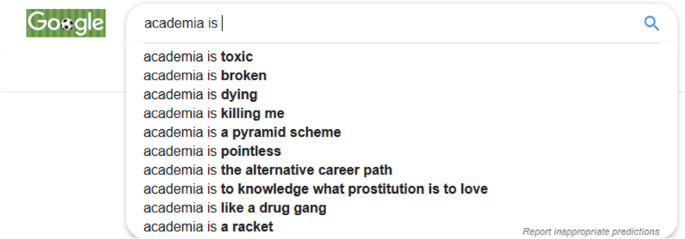
Universities have been described as “Anxiety Machines” [ 6 ]. Mental health problems are at levels described as ‘epidemic’, with one study showing staff referrals for counselling increasing by between 50% to over 300% between 2009 and 2016 [ 6 ]. These problems have been linked at least in part to excessive workloads and demands in an increasingly competitive culture.
Are high performance and happiness incompatible?
Highly successful academic teams require intensive focus and effort; this may be perceived as incommensurate with a happy workplace. A web scan of publically available university strategic plans shows that many focus heavily on performance yet lack consideration of strategies that can foster enhanced staff happiness and wellbeing. Possibly, the latter are generally not considered as important in the ‘rankings race’.
Happiness makes people more productive at work. One study found that happiness resulted in a 12% increase in employee productivity, whereas unhappy workers were 10% percent less productive than average [ 7 ]. Psychological wellbeing is also positively correlated with staff retention [ 10 ], which is particularly important in a university context considering the long lead times required to build a successful research program. Promoting happiness among university staff is a worthy goal.
Our experience shows that fostering a high performing academic team is not incompatible with staff happiness. Our School has been twice ranked number one globally in its discipline (Academic Ranking of World Universities (ARWU) 2016, 2017; 3rd in 2018) ( www.shanghairanking.com ). In addition, our staff survey and Early-Mid Career Researcher (EMCR) evaluation results show that our staff feel happier and more supported when benchmarked against the broader university sector. Staff survey results show, for example, that on measures of feeling supported in research (‘I am given enough support to achieve my research goals’), our staff score 27 percentage points higher than the sector average. On indicators of wellness (‘I feel emotionally well at work’; ‘I am able to manage stress at work’), our staff score 5–8 percentage points higher, and on various measures of job satisfaction our staff score 4–6 percentage points higher than the sector average. Similarly, evaluation showed that our School’s EMCR initiatives were associated with increased career satisfaction and morale, and decreased perceived distress.
We’ve implemented initiatives that focus on people and their happinness, as well as performance. These include a dedicated role with oversight of the development, care and support of early- and mid-career researchers through a range of mentorship, face-to-face and virtual support channels.
Academic workloads are an often-cited source of stress, and evidence shows that researchers who are happy are those who have time (particularly unfragmented time) to do research [ 2 ]. We designed strategies to create uninterrupted time, including batched teaching within semesters, and an ‘internal sabbatical’ program to free up extended time for staff to advance their research without teaching commitments.
Other strategies we have implemented include providing flexibility to allow staff to work to their strengths; adhering to publication guidelines whereby authorship is truly representative of inputs; greater recognition of not just winning funding but having a go; and encouraging and modeling a team-based approach in which individuals are not just working in a group, but encouraging colleagues to look out for and after each other at all levels. This is consistent with evidence that shows building social interactions and high-quality connections fosters knowledge-intensive workers’ happiness at work [ 8 ]
Other leading groups have adopted similar initiatives. The University of Ghent has recently initiated an approach that directly addresses the signs of increasing pressure on academic staff. Their new model emphasises staff development; collegiality rather than competitiveness; reduced reliance on quantitative metrics; and being a ‘caring’ employer ( https://www.u4network.eu/index.php/news/2707-ghent-university-is-changing-course-with-a-new-career-model-for-professorial-staff-press-release-ghent-17-september-2018 ).
A successful and happy research team does not just happen. To grow research, you need to grow and nurture researchers. This means more than the usual professional development opportunities, annual performance meetings, perks such as subsidised gyms or childcare and performance bonuses. In our experience, leadership is the key. Modern reseach leadership is not about being the most successful or highest-cited academic - it is about a commitment to supporting and developing others, and creating an environment in which they can succeed. Leadership styles which focus on people have greater impact on happiness at work compared to transactional leadership styles [ 8 ].
Nurturing a successful and happy research team
Based on our experience and the existing evidence, we advocate a shift in academic leadership, cultures, training and practice, towards a kinder, more people-focused approach. Our top tips for academic leaders interested in growing successful and happy research teams include:
Focus on individuals and their career development
Facilitate career conversations and pathways that offer opportunities for development. Set up one-to-one mentoring relationships and a culture in which senior staff are expected to mentor not only their direct reports but others from whom they stand to gain no ‘KPI’ benefit.
Prioritise staff happiness and wellbeing
Seek ways to reduce, not increase, staff workloads. Allow staff to set their own schedules and enable uninterrupted times for scholarly contemplation and research. Encourage and model a balanced perspective, with sensible working hours, in which work is not the only or most important component of life. Support collegial social events.
Foster a culture of kindness
Academia is very good at teaching us to be critical, but neglects to skill staff in practices embodying kindness, despite evidence that such practices improve organisational effectiveness [ 1 ]. Encourage workplace kindness through expressing appreciation and gratitude to staff. Tell staff what you value about them. Share and celebrate staff successes, and foster a caring attitude to ‘rejections’. Embody a leadership approach that is both empathic and holistic, considerate to the ups and downs of non-work, as well as working life (for example through allowing greater flexibility in terms of staff work hours and locations during challenging life circumstances). Model respectful treatment of colleagues and compassionate support. When hiring new staff, seek those who are caring as well as competent.
Challenge cultures and workplace models
- in which all academics must be all things. Instead endorse essentialism [ 5 ]: the disciplined pursuit of less. Recognise that performance can be judged collectively across teams in which people have strengths across different domains – some are outstanding writers; others, great orators/teachers; others masters at industry engagement; others science communicators or policy influencers. Allow people flexibility to specialise and channel time and effort into making the best possible contribution to the most meaningful and important activities as part of a successful team.
Advocate for a kinder approach to metrics
Foster collaborative, team-based approaches focused on improving the research quality of the team, rather than on metrics per se. For example, a focus on strengthening team members’ research skills and shared learning can both improve team ethos and raise collective rankings. We advocate that new rankings should incorporate a focus on the happiness of staff, given the strong case that happy, engaged workplaces foster both staff wellbeing and organisational productivity.
Availability of data and materials
Cameron K, Mora C, Leutscher T, Calarco M. J Appl Behav Sci. 2011;47(3):266–308.
Article Google Scholar
Duncan R, Tillbrook K, Krivokapic-Skoko B. Aust Univ Rev. 2015;57(1):5–12.
Google Scholar
Goglio V. J High Educ Policy Manag. 2016;38(2).
Goodall A. 2013. https://www.timeshighereducation.com/features/top-20-ways-to-improve-your-world-university-ranking/410392.article . Accessed 9 Jan 2020.
McKeown G. Essentialism: The Disciplined Pursuit of Less. 1st ed. New York: Crown Business, Random House LLC; 2014.
Morrish L. Pressure vessels: the epidemic of poor mental health among higher education staff. HEPI occasional paper 20. 2019. https://www.hepi.ac.uk/wp-content/uploads/2019/05/HEPI-Pressure-Vessels-Occasional-Paper-20.pdf . Accessed 9 Jan 2020.
Oswald A, Proto E, Scroi D. J Labor Econ. 2015;33(4):789–822.
Salas-Vallina A, Alegre J, Guerrero RF. Eur Res Manag Bus Econ. 2018;24:149–59.
Vernon MM, Balas EA, Momani S. PLoS One. 2018;13(3):e0193762.
Wright TA, Bonett DG. J Manag. 2007;33(2):141–60.
Download references
Acknowledgements
Author information, authors and affiliations.
Institute for Physical Activity and Nutrition, Deakin University, Geelong, VIC, Australia
Kylie Ball & David Crawford
You can also search for this author in PubMed Google Scholar
Contributions
Both authors drafted the commentary. Both authors read and approved the final manuscript.
Corresponding author
Correspondence to Kylie Ball .
Ethics declarations
Ethics approval and consent to participate.
N/A (data cited are from existing reports).
Consent for publication
Competing interests.
The authors declare the following competing interests: KB receives income from a Career Development consultancy, Indago Academy, which she founded.
Additional information
Publisher’s note.
Springer Nature remains neutral with regard to jurisdictional claims in published maps and institutional affiliations.
Rights and permissions
Open Access This article is distributed under the terms of the Creative Commons Attribution 4.0 International License ( http://creativecommons.org/licenses/by/4.0/ ), which permits unrestricted use, distribution, and reproduction in any medium, provided you give appropriate credit to the original author(s) and the source, provide a link to the Creative Commons license, and indicate if changes were made. The Creative Commons Public Domain Dedication waiver ( http://creativecommons.org/publicdomain/zero/1.0/ ) applies to the data made available in this article, unless otherwise stated.
Reprints and permissions
About this article
Cite this article.
Ball, K., Crawford, D. How to grow a successful – and happy – research team. Int J Behav Nutr Phys Act 17 , 4 (2020). https://doi.org/10.1186/s12966-019-0907-1
Download citation
Received : 06 November 2019
Accepted : 23 December 2019
Published : 14 January 2020
DOI : https://doi.org/10.1186/s12966-019-0907-1
Share this article
Anyone you share the following link with will be able to read this content:
Sorry, a shareable link is not currently available for this article.
Provided by the Springer Nature SharedIt content-sharing initiative
- Academic wellbeing
- Research culture
International Journal of Behavioral Nutrition and Physical Activity
ISSN: 1479-5868
- Submission enquiries: Access here and click Contact Us
- General enquiries: [email protected]
FYI, something just happened!
This is just an info notification message.
You must fill all fields
Wait, I must warn you!
This is just a warning notification message.
This is just a success notification message.
Pimp Your Science
Despite busy schedules and pressing obligations group leaders should consider investing in development of efficient Life Science teams within their groups. The bigger the group the higher necessity for group-to-team transformation. When properly build, research teams are not only highly productive and cut lab running costs, but are also autonomous and self-directed. So, no need for a tight supervision. In this video, I provide you with easy to understand information on team building process together with tips and strategy how to proceed in each phase of team maturation: forming, storming, norming, and performing.
Tips to lead an effective research team
(adopted from UC Berkeley, https://hrweb.berkeley.edu/guides/managing-hr)
The first rule is an obvious one: to lead a team effectively, you must first establish your leadership with each team member. Remember that the most effective team leaders build their relationships of trust and loyalty, rather than fear or the power of their positions.
- Consider each employee's ideas as valuable. Remember that there is no such thing as a stupid idea.
- Be aware of employees' unspoken feelings. Set an example to team members by being open with employees and sensitive to their moods and feelings.
- Act as a harmonizing influence. Look for chances to mediate and resolve minor disputes; point continually toward the team's higher goals.
- Be clear when communicating. Be careful to clarify directives.
- Encourage trust and cooperation among employees on your team. Remember that the relationships team members establish among themselves are every bit as important as those you establish with them. As the team begins to take shape, pay close attention to the ways in which team members work together and take steps to improve communication, cooperation, trust, and respect in those relationships.
- Encourage team members to share information. Emphasize the importance of each team member's contribution and demonstrate how all of their jobs operate together to move the entire team closer to its goal.
- Delegate problem-solving tasks to the team. Let the team work on creative solutions together.
- Facilitate communication. Remember that communication is the single most important factor in successful teamwork. Facilitating communication does not mean holding meetings all the time. Instead it means setting an example by remaining open to suggestions and concerns, by asking questions and offering help, and by doing everything you can to avoid confusion in your own communication.
- Establish team values and goals; evaluate team performance. Be sure to talk with members about the progress they are making toward established goals so that employees get a sense both of their success and of the challenges that lie ahead. Address teamwork in performance standards. Discuss with your team:
- What do we really care about in performing our job?
- What does the word success mean to this team?
- What actions can we take to live up to our stated values?
- Make sure that you have a clear idea of what you need to accomplish; that you know what your standards for success are going to be; that you have established clear time frames; and that team members understand their responsibilities.
- Use consensus. Set objectives, solve problems, and plan for action. While it takes much longer to establish consensus, this method ultimately provides better decisions and greater productivity because it secures every employee's commitment to all phases of the work.
- Set ground rules for the team. These are the norms that you and the team establish to ensure efficiency and success. They can be simple directives (Team members are to be punctual for meetings) or general guidelines (Every team member has the right to offer ideas and suggestions), but you should make sure that the team creates these ground rules by consensus and commits to them, both as a group and as individuals.
- Establish a method for arriving at a consensus. You may want to conduct open debate about the pros and cons of proposals, or establish research committees to investigate issues and deliver reports.
- Encourage listening and brainstorming. As supervisor, your first priority in creating consensus is to stimulate debate. Remember that employees are often afraid to disagree with one another and that this fear can lead your team to make mediocre decisions. When you encourage debate you inspire creativity and that's how you'll spur your team on to better results.
- Establish the parameters of consensus-building sessions. Be sensitive to the frustration that can mount when the team is not achieving consensus. At the outset of your meeting, establish time limits, and work with the team to achieve consensus within those parameters. Watch out for false consensus; if an agreement is struck too quickly, be careful to probe individual team members to discover their real feelings about the proposed solution.
- Communication skills
- Personal competences
- Powerful teamwork
- LSD Program
February 11, 2022
How to Be a Great Leader in Science
Building a positive research environment requires intention, support and a belief that kindness isn’t weakness
By Alison L. Antes

FG Trade/Getty Images
There is a common narrative, in academia and beyond, that says, “You have to be a jerk to be successful.” As a scientist who studies what makes a great leader, it is disheartening how often research trainees and junior faculty in the sciences ask me if this is true.
So, it’s been an especially eye-opening week for science, as academics reflect on Eric Lander’s resignation from his roles as the director the Office of Science and Technology Policy and White House science adviser. A whistleblower investigation found that he had bullied and mistreated his staff , and seemed to be especially abusive toward women who worked with him.
Scientific research demands creative and complex work. Such creativity and technical skill thrive in workplaces that are psychologically safe and supportive . I can tell you that for every abusive supervisor, there are multitudes who inspire, nurture and respect the people who work for them. Leadership is a big responsibility, and in a field rife with setbacks, failure and pressure, it can be hard to get it right all the time. But we have to; we are losing talented people who either drop out of academic life because they have been bullied or abused, or are worried about it. These losses are a detriment to academia, science and society.
On supporting science journalism
If you're enjoying this article, consider supporting our award-winning journalism by subscribing . By purchasing a subscription you are helping to ensure the future of impactful stories about the discoveries and ideas shaping our world today.
Here are some tips on positive leadership and bolstering academics in developing and sustaining good leadership practices.
Know who you want to be.
Great leaders know what character traits they want to define their leadership. For example, integrity, honesty, kindness, optimism, passion, determination and fairness. They reflect on the traits that already define who they are and those they need to cultivate. They seek out positive role models and mentors, always seeking to learn and grow . They ask for input on their leadership from their peers, staff and supervisors and take criticism well. They are not afraid to show vulnerability and don’t feign perfection. They learn from their mistakes and couple self-confidence with humility. Great leaders strive to take care of themselves by managing their own stress and external pressure.
Know what you value in a work environment.
Great leaders know what qualities they want to define their work environments. For instance, you can value trust, openness, integrity, respect, support, accountability, cooperation, creativity, excellence, engagement, learning and inclusion. Great leaders recognize that their own behavior sets the example. They tell their team members what they value and prioritize these qualities in their decisions and actions. They bring in newcomers who are committed to these qualities and expect respectful conduct. Great leaders look for cues and ask for input to assess the status of the work environment.
Be intentional. Budget the time.
Positive leaders make creating a supportive and affirming environment an explicit priority. They make time to build trust and develop healthy working relationships. They communicate openly, listen effectively and show empathy. They treat people with respect to bring out their best.
Know and develop your people.
A powerful way that a leader can build relationships and foster effective performance is by understanding the interests and career goals of their staff, especially trainees. A great leader mentors and coaches staff, sets high expectations and provides the guidance and resources to achieve expectations. They also celebrate the small successes along the way.
Create space for everyone.
Great leaders ensure everyone gets a chance to speak, and they acknowledge everyone’s contributions. They create space for new ideas, encourage collaboration and insist that team members communicate respectfully. They establish norms for handling mistakes that makes it acceptable to mess up. They embrace productive conflict and engage in difficult conversations. They welcome different personalities, perspectives and backgrounds .
Cultivate a collaborative spirit.
A great leader supports team members in building their own trusting, healthy workplace relationships . A successful scientist once told me he tells his group they may be competing with other labs, but inside their laboratory, they are a team. Research is competitive, but ambition need not squeeze out respect, kindness, and cooperation .
Foster a safe environment.
In a safe environment, people feel respected and engage fully without fear of ridicule or judgment. They ask for help and clarification, offer solutions to problems, admit errors, raise concerns, disagree, and give and receive feedback. These behaviors are essential to conducting rigorous, trustworthy research. Leading by intimidation creates fear and anxiety. It breeds distrust, secrecy and misbehavior. It causes people to quit and impacts their mental health .
Promote a top-down positive culture.
Becoming a great leader also requires support from the top down. Institutions need to provide leadership development. They need to reward positive behavior. They need not only to have no-tolerance policies for bullying and abuse, but also to enforce those policies. Both institutions and the broader academic systems need to celebrate the success stories of great leadership and create space to discuss failures. All of these steps are critical for creating a true and lasting shift in the narrative and culture.
Might the circumstances today be different if Lander had heeded this leadership advice ? How might providing leadership training and coaching to all researchers across their careers transform academia? What if it were the norm for researchers to talk about people skills? What if research trainees and staff could count on being safe and supported in research environments? What if they felt empowered to speak up about abusive behavior?
Academics are exceptional at learning, problem-solving, and rising to a challenge. I think that we are ready to create these needed changes, and I believe that we must.
Job Seekers
Business Solutions
- Contractors
Meet the team
- CSR & Partnerships
Refer A Friend
How to Lead a Research Team in 4 Steps
Share Our Blog

Despite talent management in research being the greatest driver of research success , researchers are seldom taught how to lead a research team well.
In fact, research from the Wellcome Trust where over 4,000 scientists were surveyed, reveals that while 80% of lead researchers say they have the skills to manage a diverse team, less than half of research leaders have had any management training.
Successfully implementing talent management practices in a time-sensitive laboratory environment can be complex and remains a key area in need of improvement even for industry leaders in the scientific field.
However, when leaders do rise to the challenge, they can generate an environment of continual improvement, increased efficiency and greater satisfaction. In this article, I’ll outline 4 key steps, inspired by Psychologist Bruce Tuckman’s notorious theory of group development . Expect to find:
- 4 steps to successful leadership
- Research and insights on laboratory leadership
- Key skills information for research leaders
Four key steps to leadership success
Step 1 – form a vision and set your strategy.
While mission statements involve describing the purpose of your research itself, a vision statement should outline the project’s full trajectory while staying connected to the mission.
Your wider strategy and vision statement should include details around:
- Staff career plans – understanding your team’s ideal career trajectory will enable you to better share opportunities and responsibilities.
- Timelines for the project – clarifying clear timelines from the start can improve your chances of gaining additional funding.
- Communication channels – find reliable ways to maintain communication, ideally through weekly updates.
- Financial goals – aim for any additional funding opportunities from the project’s outset.
- Approach to work-life balance – understanding your team’s need for a work-life balance will help shape the trajectory of the project, and timelines, by setting realistic goals
- Development opportunities – describe any additional training and development opportunities that are available over the course of the project
- Enabling innovation – foster a creative environment from the outset, creating a psychologically safe environment where people can suggest new ideas.
- Building connections – collaboration can open up a wealth of opportunity and resource.
Vision statements should be a collaborative affair, where your team contribute their perspectives to shape a realistic and meaningful vision for the project.
A strong research vision describes the unique way a challenge will be addressed in context of its wider societal, environmental or even industrial impact.
Syngenta accomplish this with the vision statement below:
“Our vision is a bright future for smallholder farming. To strengthen smallholder farming and food systems, we catalyze market development and delivery of innovations, while building capacity across the public and private sectors” Leadership tip: While creativity is often regarded as key to research culture, 75% of researchers believe it’s being stalled. Overcoming this takes conscious action, and psychological safety. Google’s research shows that psychological safety is one of the greatest drivers for successful teamwork. Leaders can achieve a more innovative, and successful team culture by showing concern for wellbeing alongside success.
Step 2 – Bridge communication gaps and work through the challenges
Once you’ve successfully set up the vision and strategy behind your project, your attention can shift onto working through the challenges that arise and bridging any communication gaps that emerge. Your focus as a leader should be on promoting learning and providing the constructive feedback needed to help your team turn mistakes into lessons learned.
When faced with a hurdle, consider additional training where skills are insufficient, and stay committed even if the project isn’t going at the pace you expected.
Leadership tip: It’s also important to practice self-awareness and identify whether any research challenges could be down to your leadership style. If you don’t find your leadership style to be driving your team’s motivation, be prepared to change up your approach. Research shows you can do this by asking ‘what’ you can do to change, rather than focusing too much on ‘why’ your approach wasn’t successful.
Step 3 – Sustain performance
Now your project has overcome its growing pains, it’s likely that productivity has increased and that you’re looking for ways to keep that momentum going.
Emphasising project ownership and accountability is integral at this stage and can help sustain motivation and commitment to the research. As the research continues, it’s important to leverage communication channels, and keep conversations and ideas flowing – doing so, will better enable problem solving if further issues do arise.
Your responsibilities will largely shift at this point to monitoring:
- Time – the time it takes to complete projects, as well as the time the team are spending in the lab.
- Money – how finances are progressing, and whether further resourcing may be required.
- Quality of work – the quality of work should take a greater focus over the quantity of work, although both are important.
- Work-life balance – refer back to the vision for the project; is the same work-life balance being maintained?
- Burnout – monitor employee wellbeing and try to identify signs of employee burnout early.
Leadership tip: To maintain productivity, it’s important to move away from a competitive culture. 78% of researchers think that high levels of competition in the laboratory have created unkind, and aggressive conditions . Celebrate achievements and consider how you can help encourage team growth and development rather than focusing on a competitive environment.
Step 4 - Prepare for wrap-up
As the project draws to a close, your role as a leader should shift on to developing your team member’s career beyond the project. You can refer back to your project vision, as well as actively communicate with your wider team to ensure that every member is accessing the opportunities that they need to transition to their next research project and role.
You could organise a final event for the team to celebrate personal achievements alongside overall team achievements to close the project in a positive way.
Leadership tip: Establishing a successful offboarding process as a leader is crucial to maintaining a strong network with wider research teams, even after project completion.
Skills breakdown:
Key skills Research Managers require to achieve laboratory success are:
- Self-awareness
- Time management
- Accountability
Looking for resource support?
At Synergy , we provide specialist teams that boost laboratory capability, potential and efficiency from within. (www.srgtalent.com/clients/our-services/synergy-scientific-solutions)
Our links with SRG’s expansive talent networks mean we can source, manage and develop teams on behalf of our clients across the clinical and biotech industries.
Want to learn more? Get in touch with our team at: [email protected]
Latest News, Events & Insights

Simple and Effective Ways to Drive Diversity & Inclusion in Leadership
A company’s leadership sets an example. If diversity and inclusion in a leadership is lacking, it can have a damaging impact. Here are a few simple, effective tips from SRG to help get it right.

HeadFirst Group and Impellam Group join forces
HEADFIRST GROUP AND IMPELLAM GROUP JOIN FORCES TO BECOME A GLOBAL LEADER IN STEM, DIGITAL AND IT TALENT, MANAGED SERVICES AND HR TECH

The Women Who Helped Shape STEM – Trailblazers in the world of science and beyond
Inspirational women have been at the heart of STEM, shaping the world of science and beyond, for centuries. Here we celebrate just a few of them, along with their game-changing innovations.

How to Create a Hiring Strategy For The STEM Market
Pharmaceutical careers involve working at the threshold of medical innovation – whether your job is within drug development, leadership, or advertising, there’s a role where every skill set can make an impact on the wider world of health.

National Inventors Month 2023 – 4 Influential Inventors who Transformed the World
In celebration of National Inventors Month 2023, we're recognising four instrumental inventors whose extraordinary minds helped shape our contemporary world.

How to Upskill for Digital as An Industrial Chemist
Learn how to upskill for digital as an industrial chemist with advice from Head of Chemicals, Faye Allison.

3 Ways to Thrive in Laboratory Management
Tony Blick, Synergy, explore the impact skills shortages are having on laboratories today, and provide 3 key ways to support the most significant challenges faced in laboratory management.

4 Challenges to Motivation at Work and How to Overcome Them
Chris Beckenham explores results from our latest candidate community survey and reveals strategic advice to overcome the hurdles and power motivation in the workplace.
Want to Know More?
Subscribe to our newsletter.
Stay up to date with SRG
Latest Salary Survey
SRG are industry leaders and work with 3rd party vendors for market intelligence
Get in Touch
0161-526-1901
For Job Seekers
- Staffing Solutions
- Executive & Technical Search
- Managed Service Provider & Contingent Workforce Solutions
- Pre-Clinical Discovery Science
- Early Talent in STEM
- Recruitment Process Outsourcing and Permanent Workforce Solutions
- Statement of Work (SOW)
- Salary Benchmarking
- Meet the Team
- SRG Scotland
- News & Insights
- Guides & Reports
- Podcasts & Webinars
- Career Advice
- Case Studies
- Whistleblowing policy
- Accessibility
- Carbon Reduction Plan
- ED&I statement
- Gender Pay Gap Report
- Cookie Policy
- Privacy Policy
- Modern Slavery Statement
- Terms and conditions
- Complaints Procedure
© 2024 SRG.
- Gender pay gap report
- Share on twitter
- Share on facebook
Career advice: how to lead a research team
Five top european academics offer advice on how to mentor, manage and expand a research team.
- Share on linkedin
- Share on mail
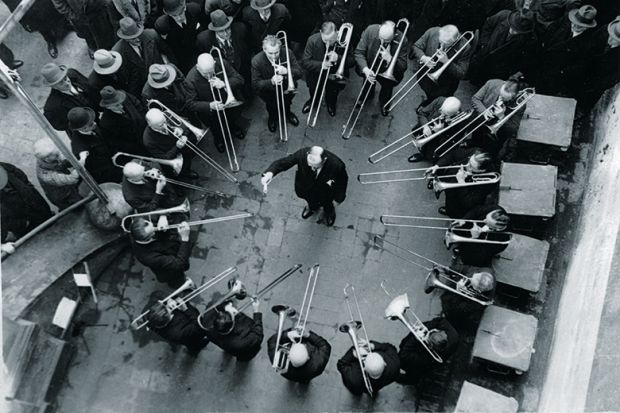
Leading a research team is one of the toughest tasks in academia. Here, five senior research heads offer their top tips on making it as a principal investigator.
Rudi Balling Director of the Luxembourg Centre for Systems Biomedicine, University of Luxembourg
Always think about keeping the members of your team happy. Show them appreciation, care for them and respect that they might be different.
Think about how you wanted to be treated by your boss when you were a student. [US scientist] David Altshuler once said: "Nobody works for me. I work for them” – this is something every leader should internalise.
Something that is still painful for me is when young people who had all the freedom to develop and who had a long leash turn into dictators as soon as the leash is cut.
Bob Siegerink Head of the clinical epidemiology team at the Center for Stroke Research in Berlin, who is based at Charité Universitätsmedizin Berlin
Organise an environment in which you can learn, preferably with regular feedback and mentoring. Some universities have formal mentor programmes, but I just make sure that I have more experienced researchers whom I can ask for advice and feedback.
Discuss issues around setting up your own team with friends who are not in academia. Starting your own research team sounds as if it is very different from what your friends that studied business, law or even art are doing, but, let’s be honest, it is just the first career move into middle management.
Sharing stories and comparing notes helps me to better understand academia and what I can do to improve myself and the team.
Wendy Ayres–Bennett Professor of French philology and linguistics, University of Cambridge , who is leading a £3.2 million Arts and Humanities Research Council-funded project on multilingualism
Make sure you [budget for] sufficient, good-quality administrative support for the research project because there are always a lot of personnel and organisational issues that need constant monitoring and chasing . Without such support, you find yourself with little time to pursue your own research agenda.
If international partners are involved, it is also important to be clear from the outset what the obligations are in terms of outputs and outcomes. They may not feel the same urgency as you without the pressure of being answerable to a funder or the obligations of the research excellence framework.
Stephanie Haywood Director of the Centre for Adaptive Science and Sustainability and head of electrical and electronic engineering at the University of Hull
The first problem is growing your team . This will often begin with just a PhD student and you, in a new and unfamiliar institution, so find a mentor and a role model. Look around you and see who is running a successful research group and doing it in a way that you would be happy to emulate. Mentors are often assigned to new staff, but don’t be afraid to find your own unofficial ones – they usually work best.
If you are lucky, there will be supportive senior colleagues willing to help, advise and provide an extended research family for you and your embryonic research group to draw upon as you expand. Take all that is offered in this respect. Don’t feel you have to prove your independence by going it alone from the outset.
The most difficult change from being a researcher to a lecturer is probably that, by necessity, teaching takes priority several days a week in term time. Research rarely reaches quite the same level of urgency, so prioritise research for specific days every week and stick to it as firmly as you can.
It helps greatly to have self-motivated PhD students and post-docs knocking on your door with problems for you to solve and results they want to discuss. So recruit carefully and then encourage your team to disturb you – it really drives the research forward.
Robert MacIntosh Head of the School of Social Sciences, Heriot-Watt University
Moving from sole trader to plc status is not something that everyone achieves gracefully.
With the transition to any managerial role, the trick is to avoid micro-managing to the point where you are doing everyone else’s job for them. Try to remember what level of competence you had at the point in your career when you hadn’t done much.
Without being trite, focus on feedback that will help members of your research team to realise where they’re not hitting the standard required and do so early, often and optimistically.
Above all, try to avoid “when I was at your stage” rants, or at least reserve them for therapy with colleagues when off campus.
POSTSCRIPT:
Print headline: Leading by example
Register to continue
Why register?
- Registration is free and only takes a moment
- Once registered, you can read 3 articles a month
- Sign up for our newsletter
Or subscribe for unlimited access to:
- Unlimited access to news, views, insights & reviews
- Digital editions
- Digital access to THE’s university and college rankings analysis
Already registered or a current subscriber? Login
Related articles

Career advice: how to choose the right candidate for the job
Our experts reveal how they seek to choose the right person for the job when faced with a pile of flawless CVs and glowing references

Career advice: how to ask an end-of-interview question
Senior academics and university administrators offer their top tips on how to ask that awkward question at the end of a job interview

Career advice: how to do a Skype job interview
In the first of a new series of articles, leading academics and university administrators will share tips on how to get ahead in higher education. Here, those involved in hiring explain how to handle a Skype interview
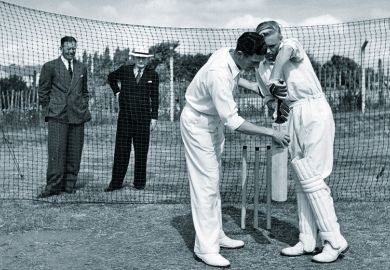
Career advice: how to handle an internal interview
Our panel of leading university administrators explain how applicants should approach a meeting of this kind at their institution

Related universities
Heriot-watt university, humboldt university of berlin, university of cambridge, reader's comments (1), you might also like.

Fewer than one in six female students chooses a STEM degree
Increased share of women in higher education overall masks continuing indifference towards science, technology, engineering and mathematics
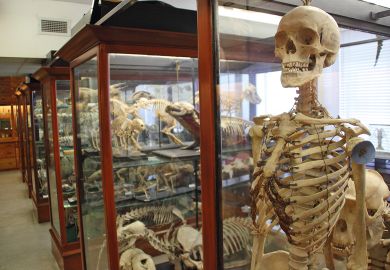
Universities ‘risk grinding to a halt’ as job cuts deepen
Institutions where hundreds of roles are at risk will have to radically change the way they operate, staff warn, with big impact on students and the wider community

‘State-directed’ public history of Troubles ‘lacks credibility’
Historians to be granted full access to state archives, but critics question relationship to controversial Legacy Act
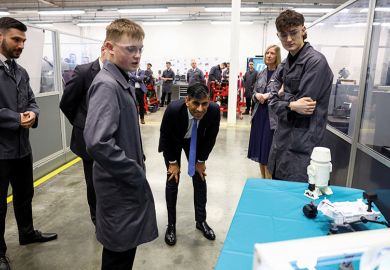
Daniel Susskind: UK should look to Google for R&D lessons
Bringing the UK’s research budget closer to Alphabet’s spending levels is vital for fixing sluggish economic growth, says economist
Featured jobs

- Research Process
Research Team Structure
- 4 minute read
- 94.7K views
Table of Contents
A scientific research team is a group of individuals, working to complete a research project successfully. When run well, the research team members work closely, and have clearly defined roles. Every team member should know their role, and how it plays into the project as a whole. Ultimately, the principal investigator is responsible for every aspect of the project.
In this article, we’ll review research team roles and responsibilities, and the typical structure of a scientific research team. If you are forming a research team, or are part of one, this information can help you ensure smooth operations and effective teamwork.
Team Members
A group of individuals working toward a common goal: that’s what a research team is all about. In this case, the shared goal between team members is the successful research, data analysis, publication and dissemination of meaningful findings. There are key roles that must be laid out BEFORE the project is started, and the “CEO” of the team, namely the Principal Investigator, must provide all the resources and training necessary for the team to successfully complete its mission.
Every research team is structured differently. However, there are five key roles in each scientific research team.
1. Principal Investigator (PI):
this is the person ultimately responsible for the research and overall project. Their role is to ensure that the team members have the information, resources and training they need to conduct the research. They are also the final decision maker on any issues related to the project. Some projects have more than one PI, so the designated individuals are known as Co-Principal Investigators.
PIs are also typically responsible for writing proposals and grant requests, and selecting the team members. They report to their employer, the funding organization, and other key stakeholders, including all legal as well as academic regulations. The final product of the research is the article, and the PI oversees the writing and publishing of articles to disseminate findings.
2. Project or Research Director:
This is the individual who is in charge of the day-to-day functions of the research project, including protocol for how research and data collection activities are completed. The Research Director works very closely with the Principal Investigator, and both (or all, if there are multiple PIs) report on the research.
Specifically, this individual designs all guidelines, refines and redirects any protocol as needed, acts as the manager of the team in regards to time and budget, and evaluates the progress of the project. The Research Director also makes sure that the project is in compliance with all guidelines, including federal and institutional review board regulations. They also usually assist the PI in writing the research articles related to the project, and report directly to the PI.
3. Project Coordinator or Research Associate:
This individual, or often multiple individuals, carry out the research and data collection, as directed by the Research Director and/or the Principal Investigator. But their role is to also evaluate and assess the project protocol, and suggest any changes that might be needed.
Project Coordinators or Research Associates also need to be monitoring any experiments regarding compliance with regulations and protocols, and they often help in reporting the research. They report to the Principal Investigator, Research Director, and sometimes the Statistician (see below).
4. Research Assistant:
This individual, or individuals, perform the day-to-day tasks of the project, including collecting data, maintaining equipment, ordering supplies, general clerical work, etc. Typically, the research assistant has the least amount of experience among the team members. Research Assistants usually report to the Research Associate/Project Coordinator, and sometimes the Statistician.
5. Statistician:
This is the individual who analyzes any data collected during the project. Sometimes they just analyze and report the data, and other times they are more involved in the organization and analysis of the research throughout the entire study. Their primary role is to make sure that the project produces reliable and valid data, and significant data via analysis methodology, sample size, etc. The Statistician reports both to the Principal Investigator and the Research Director.
Research teams may include people with different roles, such as clinical research specialists, interns, student researchers, lab technicians, grant administrators, and general administrative support staff. As mentioned, every role should be clearly defined by the team’s Principal Investigator. Obviously, the more complex the project, the more team members may be required. In such cases, it may be necessary to appoint several Principal Administrators and Research Directors to the research team.
Elsevier Author Services
At every stage of your project, Elsevier Author Services is here to help. Whether it’s translation services, done by an expert in your field, or document review, graphics and illustrations, and editing, you can count on us to get your manuscript ready for publishing. Get started today!

Writing a Scientific Research Project Proposal

Confidentiality and Data Protection in Research
You may also like.

Descriptive Research Design and Its Myriad Uses

Five Common Mistakes to Avoid When Writing a Biomedical Research Paper

Making Technical Writing in Environmental Engineering Accessible

To Err is Not Human: The Dangers of AI-assisted Academic Writing

When Data Speak, Listen: Importance of Data Collection and Analysis Methods

Choosing the Right Research Methodology: A Guide for Researchers

Why is data validation important in research?

Writing a good review article
Input your search keywords and press Enter.
7 Effective Ways to Lead Teams

Very few businesses today can exist today without effective team work. So it's surprising that while many managers are regularly coached on how to lead individuals, training in team leadership is much more rare.
Research by Harvard Business School professors might help. The following articles from our archive address several topics: why "teaming" is so important; the types of managers who make the best team leaders; temporary teams versus standing teams; what we can learn from sports teams; what leadership looks like when a team literally faces life or death, and creating a team to build a city of the future.
The Importance of Teaming
Fast-moving work environments need people who know how to team on the fly.
Pulpit Bullies: Why Dominating Leaders Kill Teams
A high-powered boss can lead a team into poor performance.
Build 'Scaffolds' to Improve Performance of Temporary Teams
Lightweight organizational structure improves performance of ad hoc teams.
It’s Not Nagging: Why Persistent, Redundant Communication Works
Managers who inundate their teams with the same messages, over and over, via multiple media, need not feel bad about their persistence.
Alex Ferguson's Lessons on Leading
Sir Alex Ferguson. perhaps the most successful professional sports coach of all time,discusses why building a team is less important than building a foundation.
Leading a Team to the Top of Mount Everest
How students learn about team communication and decision making by making a simulated climb up Mount Everest.
‘Big Teaming,’ Audacious Innovation, and the Uncompleted Dream of a Smart City
How do you organize a project that spans professions, industries, and even nations?
Related Research Papers
Research Paper: Preparing the Self for Team Entry—How Relational Affirmation Improves Team Performance
Why are teams often unable to capitalize on their collective potential?
Research Paper: Diversity and Team Performance in a Kenyan Organization
Does team diversity lead to better results?
What do you think?
What have you learned about leading teams? Add your insights to this story below.
- 26 Apr 2024
Deion Sanders' Prime Lessons for Leading a Team to Victory
- 30 Apr 2024
When Managers Set Unrealistic Expectations, Employees Cut Ethical Corners
- 27 Feb 2019
- Research & Ideas
The Hidden Cost of a Product Recall
- 24 Jan 2024
Why Boeing’s Problems with the 737 MAX Began More Than 25 Years Ago
- 01 May 2024
- What Do You Think?
Have You Had Enough?
- Groups and Teams
- Performance Effectiveness
Sign up for our weekly newsletter
Former MIT biologist David Sabatini, forced out after sexual harassment accusations, to lead new Boston team

Former MIT and Whitehead Institute star biologist David Sabatini, who lost his lofty positions after being accused of violating sexual harassment policies in 2021, is rejoining the Boston scientific community as head of a research group at a new laboratory under the umbrella of a Czech-based scientific institute.
Sabatini, who has denied harassing anyone and filed litigation over the allegations,has been working since last October in a senior research position at the Institute of Organic Chemistry and Biochemistry, in the Czech Republic capital of Prague, investigating scientific questions in the areas of cell growth and metabolism, similar to his past research at Whitehead.
The Czech institute, known as IOCB Prague, is realizing a long-held ambition to expand into the Boston biotech hub, confirmed the institute’s director, Jan Konvalinka.
“I feel adventurous about it,” Konvalinka said in a telephone interview from Prague. “My experience is that it is very important to be present where the best brains are, and where the very best universities are. It’s important to be where the decisions are being made.”
Sabatini, who will split time between Boston and Prague, will lead a research group of up to 15 people at IOCB Boston. The local branch of the Prague institute is scheduled to open late this summer, Konvalinka said. He imagines the Boston location eventually growing to two or three research groups.
Part of the funding for IOCB Boston is coming from high-profile donations pledged last year toward helping Sabatini get back into science.
For 24 years, Sabatini ran a famously intense research lab at Whitehead, overseeing up to 40 people and a $5 million annual budget. His career there ended abruptly in the summer of 2021, after a Whitehead investigation found that he had a past sexual relationship with a colleague, Kristin Knouse, over whom he had a career-influencing role, in violation of Whitehead’s policies on workplace relationships. Investigators and several former lab members also alleged the Sabatini lab had elements of a toxic environment, though other former lab members rejected those characterizations and praised the lab’s culture and Sabatini’s mentorship.
Advertisement
Sabatini in late 2021 filed suit against Knouse and Whitehead, alleging defamation among other claims. Knouse countersued Sabatini, accusing him, among other allegations, of sexual harassment and retaliation.
The litigation is ongoing.
A spokesperson for Whitehead declined to comment on Sabatini’s new position.
Lawyers for Knouse did not respond Monday to a request for comment.
Sabatini’s work once generated Nobel Prize buzz. The implosion of his career — the subject of a two-part Boston Globe Spotlight series published in January 2023 — divided the world of science. Some thought Sabatini was over-punished; others argued that he got the reckoning he deserved.
Days after the Globe Spotlight stories were published, New York hedge fund billionaire Bill Ackman and an anonymous donor pledged $25 million over five years toward helping Sabatini get back into science. Since that time, Ackman has become an outspoken and controversial national figure leading the pushback against diversity, equity, and inclusion policies in higher education. He was a prominent critic of former Harvard president Claudine Gay’s handling of accusations of antisemitism on campus after the Oct. 7 Hamas attack on Israel.
“I’m excited there are kind and generous people who have faith in my capacity to do science and have enabled me to do this,” Sabatini said in a Globe interview.
Konvalinka declined to explain in detail how the Ackman-led donations are being used at IOCB Boston. A spokesperson for Ackman declined to comment.
Sabatini said he is not ready to name precisely where the branch institute will be located, though he and Konvalinka say they have identified the roughly 9,000 square feet of Boston-area lab space required.
Several veterans of Sabatini’s former lab at Whitehead have agreed to join his team in Boston, Sabatini said.
One of them, Doug Wheeler, worked in Sabatini’s Whitehead lab from 2003 to 2005 and 2007 to 2009. He said he is joining IOCB Boston as “head of metabolomics,” and will run a small research team in his field, related to metabolism.
“Starting from scratch with philanthropic funding but zero momentum is a really interesting challenge,” Wheeler said. “To me this is an exciting experiment to sign on for.”
IOCB Prague was founded in 1953, according to the institute. It is known for developments related to antivirals, including anti-HIV compounds that are used in drugs to treat AIDS patients.
Sabatini developed a relationship with IOCB Prague after his career imploded, and the institute invited him to Prague to deliver a scientific lecture. In hiring Sabatini last fall , the institute said, “We believe that he has been punished enough for his previous actions and that the research community will be served best” if he got back to work.
Sabatini continues to develop his lab in Prague, and intends to run the Boston and Prague locations as one lab, he said. The Boston location may operate with more senior scientists, and with a greater focus on drug discovery. “We’re buying equipment,” he said. “We’re hiring some people to be ready to go.”
Robert Langer, a prolific inventor, entrepreneur, and MIT chemical engineer, said he is unaware of another foreign scientific institution running a standalone outpost in Boston. “Most institutions are usually associated with a local university,” he said by email. The key to producing substantial science at a new institute, he said, will largely come down to “attracting great people” to do the work, which can depend on elements such as space and funding.
David Lucchino, former chairman and current board member of the Massachusetts Biotechnology Council, agrees that nothing like IOCB Boston has been done here before, to his knowledge. “But I think it is a good thing,” he said. “It continues to reinforce why this area is so important to the global health care system and the solutions that we drive.”
Mark Arsenault can be reached at [email protected] . Follow him @bostonglobemark .
- Accessibility Options:
- Skip to Content
- Skip to Search
- Skip to footer
- Office of Disability Services
- Request Assistance
- 305-284-2374
- High Contrast
- School of Architecture
- College of Arts and Sciences
- Miami Herbert Business School
- School of Communication
- School of Education and Human Development
- College of Engineering
- School of Law
- Rosenstiel School of Marine, Atmospheric, and Earth Science
- Miller School of Medicine
- Frost School of Music
- School of Nursing and Health Studies
- The Graduate School
- Division of Continuing and International Education
- People Search
- Class Search
- IT Help and Support
- Privacy Statement
- Student Life
University of Miami
- Division of University Communications
- Office of Media Relations
- Miller School of Medicine Communications
- Hurricane Sports
- UM Media Experts
- Emergency Preparedness
Explore Topics
- Latest Headlines
- Arts and Humanities
- People and Community
- All Topics A to Z
Related Links
- Subscribe to Daily Newsletter
- Special Reports
- Social Networks
- Publications
- For the Media
- Find University Experts
- News and Info
- People and Culture
- Benefits and Discounts
- More Life@TheU Topics
- About Life@the U
- Connect and Share
- Contact Life@theU
- Faculty and Staff Events
- Student Events
- TheU Creates (Arts and Culture Events)
- Undergraduate Students: Important Dates and Deadlines
- Submit an Event
- Miami Magazine
- Faculty Affairs
- Student Affairs
- More News Sites
Demystifying the complex nature of Arctic clouds
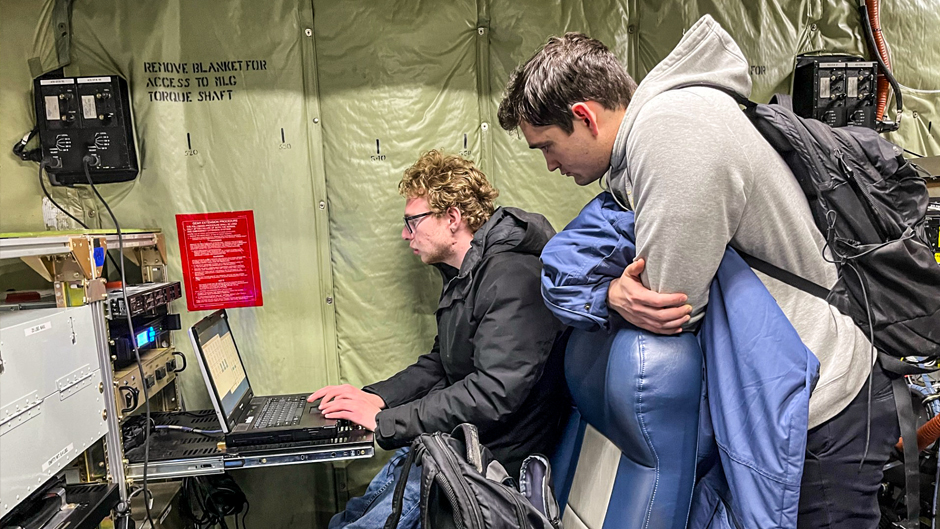
Rosenstiel School graduate students Sam Ephraim, seated, and Tyler Tatro examine data collected from instruments aboard the C-130. Photos: Courtesy of Paquita Zuidema and Sam Ephraim
By Robert C. Jones Jr. [email protected] 05-02-2024
With dancing ribbons of light visible in the sky, a team of researchers flew on a series of scenic and sometimes stormy flights into the cold unknown, trying to learn more about why one of the most frigid places on Earth is warming at a feverish pace.
The researchers—a University of Miami atmospheric scientist and her two Ph.D. students—took the flights as part of a nearly two-month-long field campaign aimed at investigating to what extent clouds generated by marine cold-air outbreaks (MCAOs) reflect and potentially contribute to the rapid warming of the Arctic while also sustaining the more extreme weather events of that polar region.

“The Arctic is changing rapidly, warming at a rate two to four times faster than the global average,” said Paquita Zuidema , professor and chair of atmospheric sciences at the Rosenstiel School of Marine, Atmospheric, and Earth Science and the principal investigator of CAESAR, or Cold-Air Outbreak Experiment in the Sub-Arctic Region. “A consensus on why and how this is occurring is still lacking, and questions remain on how clouds contribute or simply respond to these changes. The more we can learn about Arctic cloud behavior now, the better we can predict the Arctic of the future. Regardless, as the Arctic becomes more accessible, we will need to improve Arctic weather prediction in one of the most poorly observed regions of the planet.”
MCAOs, which can impact weather patterns around the world, occur when cold, dry air moves over warm ocean waters, with the difference in air and sea temperatures causing the ocean to release large amounts of heat and moisture into the air. As part of that extreme air-sea energy exchange, an extensive boundary layer of convective clouds forms, producing, at times, intense hurricane-like polar lows.
Those clouds are of a complex nature, consisting of both ice and liquid. But little is known about how they form and evolve. “Understanding how those clouds partition their moisture between liquid and ice is still not that well represented in models,” Zuidema said. “And that’s starting to be a big deal because liquid clouds reflect a lot of sunlight. Ice clouds tend to just snow out on the ground or ocean. So, we want to know, in very cold clouds, how much of that moisture is liquid and how much is ice, and why and how that change occurs?”
And that’s where CAESAR comes in. During the recent field camp, organized by the National Science Foundation’s National Center for Atmospheric Research, Zuidema and Rosenstiel School graduate students Sam Ephraim and Tyler Tatro flew out of Kiruna, Sweden, aboard a C-130 Hercules aircraft, traveling to the Arctic sea ice edge off Greenland and employing a suite of instruments that collected a wealth of data.

Dropsondes released from the C-130 recorded in-situ data on wind, temperature, and humidity as they traveled vertically through the atmosphere. Lidars, radars, and radiometers on the aircraft determined the proportion of ice and water in clouds. Instruments mounted on the aircraft’s wings sampled cloud properties, while air intakes collected aerosols for analysis.
Scientists from eight other universities in the United States as well as from Stockholm University in Sweden, the University of Oslo in Norway, and the U.S. Naval Research Laboratory also participated in the field campaign. They are examining how aerosols, air from the stratosphere, and dynamics at small scales impact cloud development. Modelers were also brought in to help facilitate a more rapid transfer of knowledge.
For Ephraim, who flew on four of the eight CAESAR flights, the campaign was more than an opportunity to observe senior scientists at work. He played a critical role in the mission’s success, operating the radiometer that measured the amount of radiation emitted from water vapor and liquid water in the air. In addition, he helped conduct weather forecast briefings for the team of scientists that determined whether flights on each day of the campaign would take off or be grounded.
“It’s one thing to sit in a classroom or at a computer and look at data on cold-air outbreaks that other people have collected in other field campaigns, but it’s quite another thing to actually be able to see it with your own eyes and to play an active role in the research,” said Ephraim, who as a little boy decided he wanted a career in meteorology after watching several hours of Weather Channel coverage.
“Our entire deployment was amazing,” he continued. “We saw the northern lights quite a bit. They were extremely active during the period we were there. And on the flights, seeing the transition of going from clear, sunny skies over the sea ice to stormy conditions was just remarkable.”
Tatro, who is studying biomass burning and aerosol cloud interactions over Africa, also assisted in operating the radiometer and helped plan some of the flights. For him, the campaign was “science from textbooks brought to life.”
“I got a sense of how much community there is in atmospheric science,” he said. “I’ve seen the names of well-known scientists in books and on research papers. Seeing them in action and collaborating with them gave me a sense of how passionate they are about their work.”
Preliminary analysis of the CAESAR data is now underway, with a dedicated session on the campaign proposed for an upcoming meeting of the American Meteorological Society, according to Zuidema.

- Coral Gables , FL 33124
- 305-284-2211 305-284-2211
- UM News and Events
- Alumni & Friends
- University Hotline
Tools and Resources
- Academic Calendar
- Parking & Transportation
- social-facebook
- social-twitter
- social-youtube
- social-instagram
Copyright: 2024 University of Miami. All Rights Reserved. Emergency Information Privacy Statement & Legal Notices Title IX & Gender Equity Website Feedback
Individuals with disabilities who experience any technology-based barriers accessing the University’s websites or services can visit the Office of Workplace Equity and Inclusion .
Adelaide research breakthrough hopes to provide more accurate prostate cancer diagnosis and treatment
Adelaide man Andrew Bills considers himself lucky, after an early diagnosis of prostate cancer five years ago.
"A lot of people say, 'You don't worry about getting prostate cancer until you're over 60'. Well I was 52," he said.
Mr Bills went through a standard series of tests to receive his diagnosis before he had surgery five months later.
"There's a lot of uncertainty because you don't know what you're dealing with, and you don't know the extent of what you're dealing with and what your options are, and it takes time," he said.
Scientists from the University of South Australia are aiming to reduce that uncertainty, with research identifying precise biomarkers for prostate cancer, making it easier to pinpoint how the cancer will progress.
Researcher Jessica Logan said current detection methods provide a "baseline overview", while the technology they were working on was about "providing an accurate and reliable diagnosis" to avoid patients from receiving too much or too little treatment.
Dr Logan said their focus was on low-risk patients.
"We know that within the first two years, there are 35 per cent of those patients [who] will require some intervention, and within five years that increases to 59 per cent," she said.
"So for those patients that are in this low-risk category ... trying to provide them with some clarity and reassurance that we are on the right treatment intervention strategies is a major focus of what we're doing," she said.
Dr Logan said Australia was looking at the most prostate cancer diagnoses this year on record.
She said it has taken researchers around 15 years to reach this stage, and it could be another five before Australians reap the benefits.
"This is I guess our first step in producing a sound data set that will facilitate potentially a clinical trial that will bring the technology here," Dr Logan said.
'Groundbreaking' research
The Prostate Cancer Foundation of Australia's Chief of Mission, Jeff Dunn, said Dr Logan's research showed great promise.
"This research is groundbreaking," Professor Dunn said.
"It helps build a platform for the way we might treat prostate cancer in the future."
Professor Dunn said the research, which the Prostate Cancer Foundation has given a grant to, could improve outcomes and quality of life for men.
"Dr Logan is using tumour-based biomarkers to help identify those prostate cancers where we need to intervene — those who are perhaps needing earlier intervention in their treatment," he said.
Professor Dunn said the research will hopefully identify which prostate cancers require earlier intervention, and therefore be able to "tailor and target treatment much more effectively".
"At the moment with prostate cancer, sometimes it difficult to determine in early stage disease which ones are aggressive and need intervention and which ones are a little slower and we just need to watch for awhile before we actually get into more complex treatment," he said.
Mr Bills said early detection was "everything", and hoped the new technology could provide more choice for patients in the future.
"I think this new technology is fundamental, because it will give men confidence about maybe not having the operation, which is very invasive, because that's really the choices that I had.
"And to leave the prostate in and monitor it, and that improves the quality of life for men."
- X (formerly Twitter)
Related Stories
Hours in the car or move house: cancer patients in this regional town face tough choice.
This prostate cancer survivor drove thousands of kilometres for health care. Now others like him don't have to
Justin was told he didn't need prostate cancer screening. Just two years later, he got diagnosed
- Medical Research
- Prostate Cancer
Take the Quiz: Find the Best State for You »
What's the best state for you ».
Global Health Heavyweights Team up for Climate, Disease Funding

FILE PHOTO: A boy receives a polio vaccine during a three-day immunization campaign in Sanaa, Yemen November 29, 2020. REUTERS/Nusaibah Almuaalemi//File Photo
By Jennifer Rigby
LONDON (Reuters) - Three of the biggest global health funders have joined forces for the first time in a $300 million partnership aimed at tackling the linked impacts of climate change, malnutrition, and infectious diseases and antimicrobial resistance.
The Novo Nordisk Foundation, Wellcome and the Bill & Melinda Gates Foundation announced the research partnership, focused particularly on finding affordable solutions for people in low and middle-income countries, in Denmark on Monday.
Each will put $100 million into the three-year initiative.
A key aim is to "break down barriers between often isolated areas of research", said Mads Krogsgaard Thomsen, chief executive officer of the Novo Nordisk Foundation.
For example, COVID-19 showed that obesity can be a risk factor for the severity of some infectious diseases, while extreme weather events linked to climate change can cause food insecurity, leaving undernourished children even more vulnerable to killer diseases such as measles and cholera.
Photos You Should See - April 2024

The partners said advances in nutritional science and understanding the gut microbiome opened the door to understanding more about "the impact over- and under-nutrition have on all aspects of health and development".
The Novo Nordisk Foundation has a controlling interest in the drugmaker Novo Nordisk (NOVOb.CO), whose blockbuster weight-loss drug Wegovy has brought in billions for the foundation since its launch in 2021.
The partners said the initiative was important given faltering global attention to health post-pandemic. Wellcome's chief executive, John-Arne Røttingen, also said it was about tackling "market failures" and signalling a global commitment to equitable access to medical advances.
The funding will also include support for researchers based in low- and middle-income countries, and the partners said they are on the lookout for private, philanthropic and public partners.
“The most effective solutions to pressing challenges often emerge from the very communities they affect,” said Catherine Kyobutungi, executive director of the African Population and Health Research Center, a leading scientific research institution.
(Reporting by Jennifer Rigby; Editing by Sharon Singleton)
Copyright 2024 Thomson Reuters .
Join the Conversation
Tags: infectious diseases , environment , public health , Denmark , Europe
America 2024

Best States

Health News Bulletin
Stay informed on the latest news on health and COVID-19 from the editors at U.S. News & World Report.
Sign in to manage your newsletters »
Sign up to receive the latest updates from U.S News & World Report and our trusted partners and sponsors. By clicking submit, you are agreeing to our Terms and Conditions & Privacy Policy .
You May Also Like
The 10 worst presidents.
U.S. News Staff Feb. 23, 2024

Cartoons on President Donald Trump
Feb. 1, 2017, at 1:24 p.m.

Photos: Obama Behind the Scenes
April 8, 2022

Photos: Who Supports Joe Biden?
March 11, 2020

Israel Begins Rafah Strikes
Cecelia Smith-Schoenwalder May 6, 2024

Trump’s Trial Enters New Phase
Lauren Camera May 6, 2024

Judge Threatens Trump With Jail
Laura Mannweiler May 6, 2024

The Week in Cartoons May 6-10
May 6, 2024, at 4:06 p.m.

Protests Threaten Campus Graduations
Aneeta Mathur-Ashton May 6, 2024

The ICC, Explained

- Campus News
- Student News
- UK HealthCare
- UK Happenings
- Arts & Culture
- Professional News
UK researchers lead a national team, transforming solid waste into aviation fuel
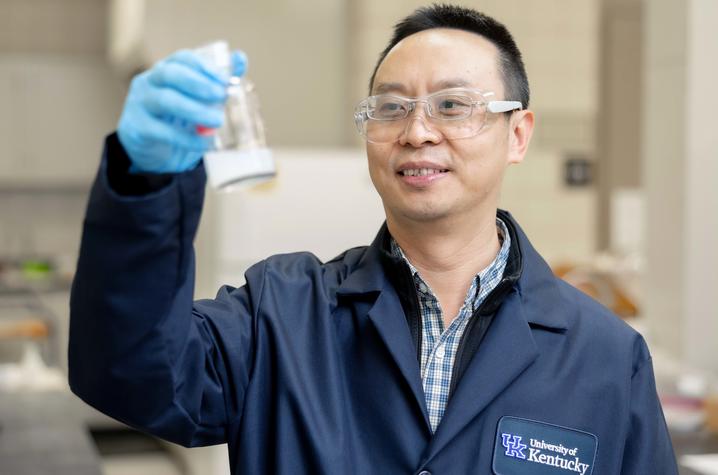
LEXINGTON, Ky. (April 25, 2024) — In a move towards sustainable energy and waste management, the University of Kentucky has launched a pioneering research initiative that seeks to turn everyday trash into high-quality sustainable aviation fuels (SAF).
Titled "Surface Enhanced Smart Preprocessing of Municipal Solid Wastes for Year-Round Supply of Conversion-Ready Feedstocks," the study aims to address excessive landfill waste. Led by Jian Shi , associate professor in the Martin-Gatton College of Agriculture, Food and Environment Department of Biosystems and Agricultural Engineering (BAE), this project has been awarded $2.12 million in federal funding from the Department of Energy (DOE).
The United States currently faces a critical challenge with over 50% of municipal solid waste (MSW) ending up in landfills, leading to increased greenhouse gas emissions and resource loss. This project seeks to address these issues head-on by developing innovative technologies to enhance the surface properties and uniformity of MSW feedstocks — facilitating their efficient conversion into biofuels and bioproducts.
"We are embarking on a journey to divert landfilled waste for bioenergy production,” Shi said. “Our goal is to transform municipal solid waste from an environmental burden into a valuable resource, paving the way for sustainable, clean energy solutions."
The project is a collaborative effort involving a multi-institutional team, including researchers from Iowa State University, Idaho National Laboratory, Red Rock Biofuels and Wasatch Integrated Waste Management.
Spanning 36 months, the initiative aims to:
- Develop novel blending and densification strategies to improve the stability and convertibility of waste plastics with biomass feedstocks.
- Implement mechanical separation methods to remove inorganic contaminants from MSW.
- Create a rapid, nondestructive 3D imaging technology for comprehensively characterizing MSW fractions.
- Use deep learning-based predictive models to guide preprocessing strategies and optimize feedstock quality.
“The team wants to try and leverage advanced 3D imaging and hyperspectral technologies to identify and categorize waste materials,” Shi said. “This technological approach allows for the efficient sorting of waste components suitable for biofuel conversion, a critical step managed through machine learning algorithms. These algorithms, akin to those used by tech giants for image recognition, play a crucial role in determining waste composition and optimizing the sorting process.”
Upon completion, the project is expected to deliver a novel preprocessing strategy tailored for converting non-recycled MSW into high-quality, conversion-ready feedstock for SAF biorefineries. This will mark a significant milestone in advancing biofuels and bioproducts research, promoting sustainable MSW-based bioeconomy and addressing the technical risks associated with the thermochemical conversion of MSW to SAF.
By turning trash into valuable jet fuel, Shi and his team are not just addressing environmental issues but are also paving the way for a sustainable industrial model that other sectors might emulate.
"We’re aiming to close the loop between waste generation and energy production,” said Mike Montross , BAE professor and co-principal investigator of the project. “We want not only to reduce landfill use and greenhouse gas emissions but also to enhance energy security by developing domestic, renewable energy sources."
This material is based upon work supported by the Department of Energy under Award Number DE-EE0010295. This report was prepared as an account of work sponsored by an agency of the United States Government. The views and opinions of authors expressed herein do not necessarily state or reflect those of the United States Government or any agency thereof.
As the state’s flagship, land-grant institution, the University of Kentucky exists to advance the Commonwealth. We do that by preparing the next generation of leaders — placing students at the heart of everything we do — and transforming the lives of Kentuckians through education, research and creative work, service and health care. We pride ourselves on being a catalyst for breakthroughs and a force for healing, a place where ingenuity unfolds. It's all made possible by our people — visionaries, disruptors and pioneers — who make up 200 academic programs, a $476.5 million research and development enterprise and a world-class medical center, all on one campus.
In 2022, UK was ranked by Forbes as one of the “Best Employers for New Grads” and named a “Diversity Champion” by INSIGHT into Diversity, a testament to our commitment to advance Kentucky and create a community of belonging for everyone. While our mission looks different in many ways than it did in 1865, the vision of service to our Commonwealth and the world remains the same. We are the University for Kentucky.
Latest Stories
Mental health awareness month: a mother's light through the darkness of suicide, danceblue clinic tests intervention to reduce financial burden on patients and caregivers, how to prevent common spring injuries, koshs highlights ladder safety for national safety stand-down week, relive the best moments from uk's may 2024 commencement ceremonies.

Research breakthrough on birth defect affecting brain size
UC Riverside-led study identifies molecular cellular mechanism linked to microcephaly
Nonsense-mediated RNA decay, or NMD, is an evolutionarily conserved molecular mechanism in which potentially defective messenger RNAs, or mRNAs (genetic material that instructs the body on how to make proteins), are degraded. Disruption of the NMD pathway can lead to neurological disorders, immune diseases, cancers, and other pathologies. Mutations in human NMD regulators are seen in neurodevelopmental disorders, including autism and intellectual disability.

Why NMD mutations are enriched in neurodevelopmental disorders remains a mystery. Sika Zheng, a professor of biomedical sciences in the School of Medicine and the founding director of the Center for RNA Biology and Medicine at the University of California, Riverside, has now led a study , published in the journal Neuron, that reveals the molecular cellular mechanism underlying NMD regulation of brain size and its dysregulation in causing microcephaly — a condition in which a baby’s head is much smaller than expected.
The team’s finding suggests that maintaining the neuronal NMD function is essential for early brain development to prevent microcephaly. According to Zheng, modulating NMD targets can be a potential treatment for microcephaly and other related neurodevelopmental diseases.
The study explains the functional roles of NMD in brain development and the underlying mechanistic action. It also demonstrates for the first time the link between mRNA decay regulation and brain size control. Additionally, it reveals the intricate connection between NMD and the most famous tumor suppressor gene, p53, suggesting possible new connections between NMD and cancer.
The research was supported by grants from the National Institutes of Health and the California Institute of Regenerative Medicine. The title of the research paper is “Epistatic Interactions between NMD and TRP53 Control Progenitor Cell Maintenance and Brain Size.” Zheng was joined in the study by Liang Chen of the University of Southern California, Chun-Wei Chen of the City of Hope, Gene Yeo of UC San Diego, and members of their labs.
Below, Zheng answers questions about the research:
Q: Why has it been a challenge to understand why NMD mutations are enriched in neurodevelopmental disorder?
A: As a surveillance mechanism, NMD targets defective mRNA arising from random mutations or RNA processing errors. This randomness is not expected to create idiosyncratic features of neurodevelopmental disorders associated with NMD factors. Furthermore, NMD occurs in all cell types and tissues, but the brain seems particularly vulnerable to NMD defects. Animal models of neural-specific NMD defects, followed by in-depth mechanistic investigation, are needed to understand why NMD mutations are enriched in neurodevelopmental disorder, which has not been conducted until now in part because of the complexity of brain development and the technical challenges of dissecting the functional NMD substrates.
Q: How did you identify the molecular cellular mechanism underlying NMD regulation of brain size and its dysregulation causing microcephaly?
A: We generated various NMD deficiency animal models by knocking out a key NMD factor, Upf2 , in different cell types and determined their phenotypic differences. We found NMD deficiency causes more impacts on the proliferative neural progenitors, which is consistent with the notion that NMD function is essential for early brain development and its mutations are enriched in neurodevelopmental disorders. Importantly, we showed NMD deficiency in progenitor cells cause microcephaly, a novel finding that links an NMD decay pathway to brain size control. To dissect the underlying mechanisms and determine functional NMD substrates causing these phenotypes, we applied cutting-edge technologies, including CRISPR screening, RNA-Seq, CLIP-seq, and single cell RNA-seq. Only through this integrative approach did we succeed in revealing the molecular underpinning.
Once we found the microcephaly phenotype, we used primary cell culture models to define the growth defects of Upf2 knockout, or Upf2 KO, in neural progenitors. Next, we applied CRISPRi screening to identify genes whose perturbation can interfere with Upf2 KO NPCs’ growth defect. Among hundreds of genes we screened, we identified a few candidates and followed on the top candidate, p53, which is well known to be a tumor suppressor gene that controls cell growth. Subsequently, we used various single cell approaches and transcriptomics technologies to determine precisely how NMD and p53 intersect in controlling cell growth.
The identification of p53 from the CRISPRi screen was a surprise to us because p53 is one of the most studied genes and many assume its genetic interactors are already identified and NMD has not made that list. Secondly, we showed deficiency in Trp53 , a gene that encodes p53 (or TRP53), did not globally reverse the NMD inhibition to rescue the growth defects. Instead, our finding suggests that the TRP53 activity intersects with NMD pathway to regulate the neuronal progenitors’ cell cycle progression. This intersection represents a very small proportion of the NMD substrates, indicating that most NMD substrates have marginal functional impacts on cell growth.
Q: The study was done using mouse cells. Can we say the results would be replicated in human cells?
A: Yes. NMD pathway is evolutionarily conserved and the key factor we focused on in the study, UPF2, is conserved between human and mouse. Other molecular players we identified in this study are also conserved. Their regulatory relationship has been replicated in human cells.
Q: What’s next for the research team?
A: We plan to build human stem cells carrying NMD mutations, so that we can modify NMD activity with drugs or regulate NMD targets to rescue phenotypes in human neurons. Additionally, we will explore whether NMD’s novel role contributes to the expansion of brain size during evolution.
Header image credit: corbac40 /iStock/Getty Images Plus.
Related Stories
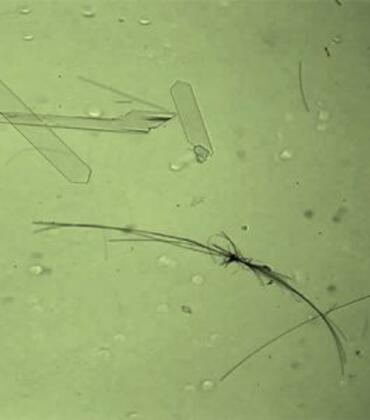
Molecular crystal motors move when exposed to light

Extracurricular: Chasing this year’s spectacular solar eclipse

Virtual villages can promote social engagement and mental wellbeing

Physics research puts UCR on landscape of particle manipulation
- Visit the University of Nebraska–Lincoln
- Apply to the University of Nebraska–Lincoln
- Give to the University of Nebraska–Lincoln
Search Form
Engel named next executive director of nebraska innovation campus.
4 days ago · 4 min read
Engel named next executive director of Nebraska Innovation Campus
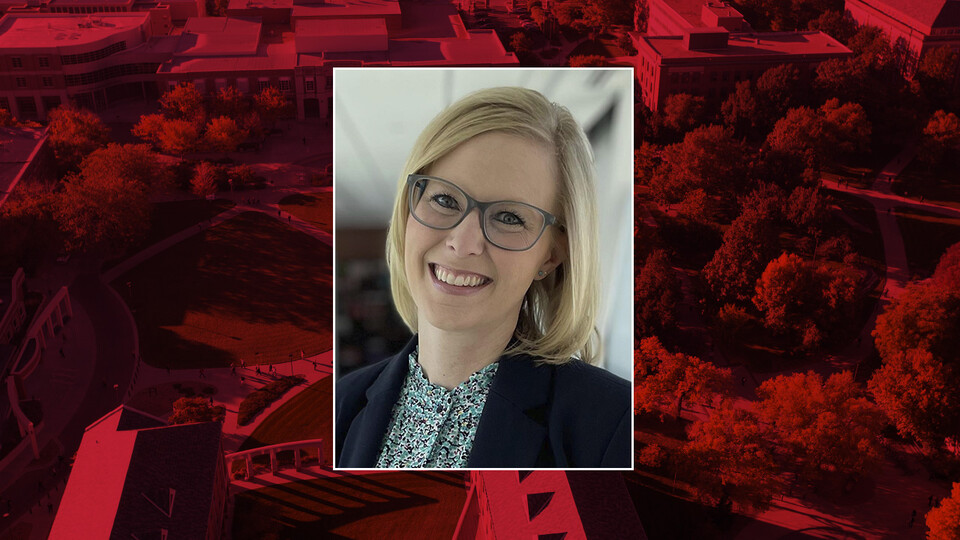
Kate Engel, an experienced leader in university-based research campus operations, has been named executive director of the Nebraska Innovation Campus Development Corporation, effective May 1. NICDC is the 501(c)(3) not-for-profit corporation that oversees Nebraska Innovation Campus.
Engel assumes the permanent role after serving one year as interim executive director. She succeeds founding executive director Dan Duncan, who retired in April 2023.
Sherri Jones, interim vice chancellor for research and economic development at the University of Nebraska–Lincoln, said Engel brings deep experience in building relationships with NIC’s current partners and leading operations and marketing.
“For more than a decade, Innovation Campus has been a valuable resource for university innovators, startup companies and economic development,” said Jones, a member of NICDC’s board of directors. “Kate has been a key contributor to the campus’s incredible growth during that time. I am confident that she is the best person to lead this vibrant campus and to ensure that NIC is a major driver of economic vitality in our community and state.”
Engel joined NIC in 2011 to assist with establishing operations and marketing before the campus’s 2012 groundbreaking. She later became director of strategic partnerships and communications, facilitating recruitment and retention, marketing and public relations, space buildouts, workforce development, and resources and programs for NIC’s partners.
NIC is home to more than 70 companies that include private businesses and University of Nebraska entities. Private-sector businesses occupy two-thirds of the campus’s 570,000 square feet of constructed space. Constructed facilities include office space; a makerspace; a conference center; The Mill Coffee and Bistro; The Scarlet Hotel, a teaching and research hotel; lab space; pilot plant space and greenhouse space. At full build-out, NIC is expected to be a 2.2 million-square-foot campus with uniquely designed buildings and amenities that encourage innovation.
“We are very excited that Kate has stepped into the role of executive director of the Nebraska Innovation Campus Development Corporation,” said Matt Williams, NICDC board chair. “Kate has been with the campus since its beginning and has great knowledge and experience to lead us forward. Innovation Campus has made great progress, and under Kate’s leadership, it will continue to contribute to the success of our university and our state.”
NICDC is owned by the University of Nebraska Board of Regents and led by a board of directors that includes private-sector members and university representatives.
Engel holds a bachelor’s degree in fine arts from Nebraska Wesleyan University, a Master of Arts in management from Doane University, a Master of Science in leadership from Nebraska and a graduate certificate in public relations and social media from UNL’s College of Journalism and Mass Communications.
Because of its rapid growth and unique approach to building a culture that fosters innovation and collaboration, NIC has received several awards of excellence from the Association of University Research Parks, the global nonprofit organization that represents university research parks, innovation districts, technology hubs and more. Under Engel’s leadership, NIC received the 2023 Outstanding Research Park Award in recognition of the partnerships, collaborations and spaces that have supported industry growth, commercialization and resources for entrepreneurs at the university and within the broader community. NIC also received AURP’s Emerging Research Park Award in 2017.
Engel received the association’s Rising Star Award in 2019 and serves on the AURP board of directors.
Engel said she is excited about NIC’s continued growth and development, including projects such as the U.S. Department of Agriculture’s National Center for Resilient and Regenerative Precision Agriculture . When completed, it will be the only federal center in the U.S. focusing on climate-resilient, sustainable and technology-driven precision agriculture. A groundbreaking ceremony for Phase 1 of the $160 million facility is scheduled for May 6.
News Release Contacts
Related links.
- Nebraska Innovation Campus
- Research and Economic Development at Nebraska
- Research and Economic Development
High Resolution Photos

Recent News
U.s.-canada trade opportunities are growing, canadian official says.
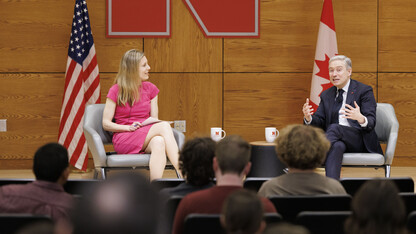
Construction begins on groundbreaking precision ag research center
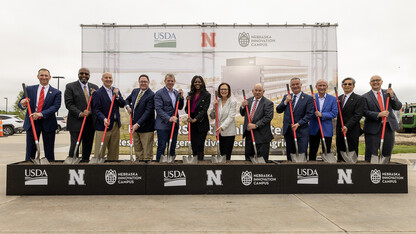
University to award 3,500-plus degrees May 17-18

Jones taking law degree to JAG Corps
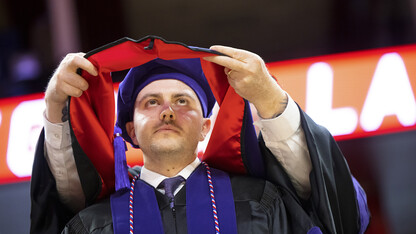
Coble reflects on research, travels as he retires after 48 years
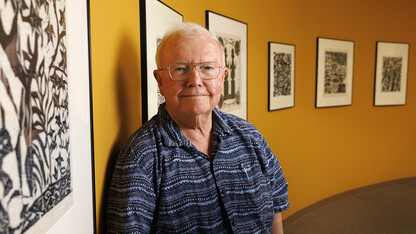
Stockham, Ovalle earn NSF Graduate Research Fellowships

Nebraska awards 155 degrees in College of Law ceremony

Engler remembered for generosity, entrepreneurial spirit


IMAGES
VIDEO
COMMENTS
In this chapter we will cover building an intentional organizational culture, being a thoughtful leader, and managing a research team so that with some foresight and effort, you can focus on your science while engaging your staff in meaningful, high-impact work as a team. Download chapter PDF.
Identifying each individual member's core strengths will help you delegate tasks more efficiently and build a better research team structure, which will in turn lead to better performance and research team work. 3. Invest in mentoring and skill-building within your research team. The best tip for how to lead a research team is to prioritize ...
1.1 Introduction . There is probably nothing new to you about working on a team. As a PhD student or a postdoc you have seen your supervisor lead a team. With luck, it will have been great fun (e.g., taking in cake for the coffee break or going out for drinks to celebrate a recently accepted article), especially if you worked on a team of people with mixed backgrounds (e.g., celebrating ...
How to lead: Five quick tips. Value different viewpoints and different ways to do research. Invite honest feedback from team members. Encourage team members to take ownership of their ...
Ideally, the balance and composition of the team in terms of skills, expertise and other contributions will be appropriate to achieve the team's objectives, i.e. for the research goal the team is working towards. The research team leader needs to be confident that team members have, or can develop, the necessary skills and knowledge for the ...
Chapter 1. Team describes how you can build up an effective team of Master's and PhD students, postdoctoral researchers, and other staff, such as technicians. Join forces with staff from human resources to optimize your most important research resource: the people. Chapter 2.
Make sure each person understands his or her roles, responsibilities, and contributions to the team's goals. As a leader, establish expectations for working together; as a participant, understand your contribution to the end goal. Recognize that discussing team goals openly and honestly will be a dynamic process and will evolve over time.
A successful and happy research team does not just happen. To grow research, you need to grow and nurture researchers. This means more than the usual professional development opportunities, annual performance meetings, perks such as subsidised gyms or childcare and performance bonuses. In our experience, leadership is the key.
The first rule is an obvious one: to lead a team effectively, you must first establish your leadership with each team member. Remember that the most effective team leaders build their relationships of trust and loyalty, rather than fear or the power of their positions. Consider each employee's ideas as valuable.
In an effective research team, the PI, in addition to all other members, must (1) define the strategies that are best suited for the team, (2) ensure the leaders are executing the defined strategies, and (3) evaluate the outcomes in accordance to whether or not the strategies helped the team reach its goal. The general framework can be used by ...
Create space for everyone. Great leaders ensure everyone gets a chance to speak, and they acknowledge everyone's contributions. They create space for new ideas, encourage collaboration and ...
Despite talent management in research being the greatest driver of research success, researchers are seldom taught how to lead a research team well. In fact, research from the Wellcome Trust where over 4,000 scientists were surveyed, reveals that while 80% of lead researchers say they have the skills to manage a diverse team, less than half of ...
A team charter is a document that clearly defines a team's purpose, goals, strategies, and team members' roles for holding each other accountable to mutual expectations. Initiated by the team leader, teams agree on clear practices for team processes such as responding to emails, attendance, and timeliness of meetings.
Team leaders should be full of ideas for new research projects and inspire a research group to achieve great results. This practical guide for team leaders, and those who aspire to become team leader, offers a unique approach to help readers develop research and become a more independent and productive investigator.
Learn from the experience of a user researcher who shares tips on how to recruit, guide, and collaborate with your research team. Find out how to use tools, questions, and methods that help you connect with users, drive impact, and build a positive culture.
1. Source: Getty. Leading a research team is one of the toughest tasks in academia. Here, five senior research heads offer their top tips on making it as a principal investigator. Rudi Balling. Director of the Luxembourg Centre for Systems Biomedicine, University of Luxembourg. Always think about keeping the members of your team happy.
4. Research Assistant: 5. Statistician: A scientific research team is a group of individuals, working to complete a research project successfully. When run well, the research team members work closely, and have clearly defined roles. Every team member should know their role, and how it plays into the project as a whole.
1. Define your vision. Be the first to add your personal experience. 2. Develop your skills. Be the first to add your personal experience. 3. Build your network. Be the first to add your personal ...
Typically the leader of the research team, the PI oversees the various research operations to ensure compliance with set procedures and guidelines. They handle process like promoting the study's ethical conduct, getting consent from the study's participants, if there are any, and for maintaining a record of the group's activities and findings. ...
2. Establish the norms and expectations. 3. Support and empower your team members. 4. Monitor and evaluate the progress and results. 5. Celebrate and learn from the successes and failures. 6.
7 Effective Ways to Lead Teams. Managers of teams require communications skills, organizational capabilities, and a knack for judging how people might work together. Research from Harvard Business School investigates the challenges of team leadership. Very few businesses today can exist today without effective team work.
A multidisciplinary team is often required to undertake high quality clinical research of national and international importance. These team members should be involved in the preparation...
Former MIT biologist David Sabatini, forced out after sexual harassment accusations, to lead new Boston team. David Sabatini at his home in Cambridge in 2022. Craig F. Walker/Globe Staff. Former ...
A team of University of Miami scientists and others recently spent weeks in the Arctic region studying marine cold-air outbreaks and how the clouds they produce can lead to extreme weather events and may be interacting with the rapidly warming Arctic. ... the University of Oslo in Norway, and the U.S. Naval Research Laboratory also participated ...
An Adelaide research team has identified precise biomarkers for prostate cancer, making it easier to predict how the disease could progress with the hope it will lead to more accurate treatment.
US News is a recognized leader in college, grad school, hospital, mutual fund, and car rankings. Track elected officials, research health conditions, and find news you can use in politics ...
By Jordan Strickler April 25, 2024. Awarded $2.12 million from the DOE, Jian Shi, Ph.D., is leading a multi-institutional team to create sustainable jet fuel while reducing landfill waste. Photo by Sabrina Hounshell. LEXINGTON, Ky. (April 25, 2024) — In a move towards sustainable energy and waste management, the University of Kentucky has ...
The title of the research paper is "Epistatic Interactions between NMD and TRP53 Control Progenitor Cell Maintenance and Brain Size.". Zheng was joined in the study by Liang Chen of the University of Southern California, Chun-Wei Chen of the City of Hope, Gene Yeo of UC San Diego, and members of their labs. Below, Zheng answers questions ...
Kate Engel, an experienced leader in university-based research campus operations, has been named executive director of the Nebraska Innovation Campus Development Corporation, effective May 1. She assumes the permanent role after serving one year as interim executive director.